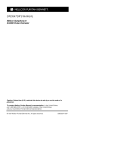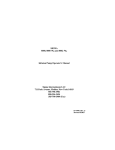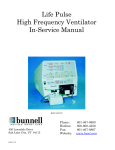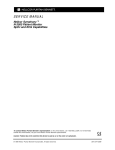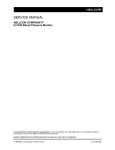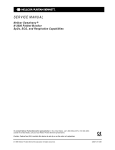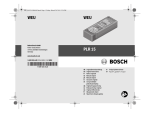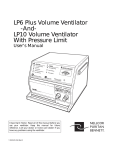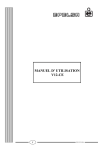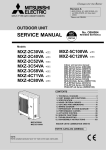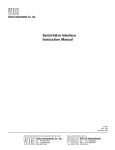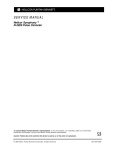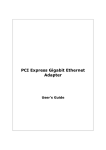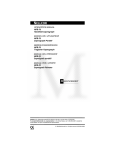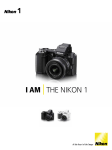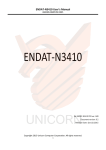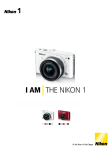Download SERVICE MANUAL - Frank`s Hospital Workshop
Transcript
SERVICE MANUAL Nellcor Symphony ® N-3200 Display/Printer To contact Nellcor Puritan Bennett’s representative: In the United States, call 1-800-NELLCOR or 510 463-4000; outside the United States, call your local Nellcor Puritan Bennett representative. Caution: Federal law (U.S.) restricts this device to sale by or on the order of a physician. © 1996 Nellcor Puritan Bennett Incorporated. All rights reserved. 012 3 035073A-1096 Corporate Headquarters Regional/Local Offices Nellcor Puritan Bennett Inc. 4280 Hacienda Drive Pleasanton, California 94588 U.S.A. Tel. 510 463-4000 or 1-800-NELLCOR Nellcor Puritan Bennett UK Ltd. 10 Talisman Business Centre London Road Bicester, Oxfordshire OX6 0JX United Kingdom Tel. +44.1869.322700 U.S. Service Repair Center Nellcor Puritan Bennett Inc. 2391 Fenton Street Chula Vista, California 91914 U.S.A. Tel. 619 482-5000 European Office Nellcor Puritan Bennett Europe BV Hambakenwetering 1 5231 DD ’s-Hertogenbosch The Netherlands Tel. +31.73.6485200 Asia/Pacific Office Nellcor Puritan Bennett HK Ltd. Room 1602 Evergo House 38 Gloucester Road Wanchai Hong Kong Tel. +852.2529.0363 Nellcor Puritan Bennett Belgium NV/SA Interleuvenlaan 62/8, Zone 2 B-3001 Heverlee Belgium Tel. +32.16.400467 Nellcor Puritan Bennett France 91975 Courtabeouf Cedex France Tel. +33.01.69.82.14.00 Nellcor Puritan Bennett Germany GmbH Black-&-Decker-Strasse 28 65510 Idstein Germany Tel. +49.6126.5930 Nellcor Puritan Bennett Italia Srl Via dei Tulipani, 3 20090 Pieve Emanuele (MI) Italy Tel. +39.2.90786404 To obtain information about a warranty, if any, for this product, contact Nellcor Puritan Bennett Technical Services or your local Nellcor Puritan Bennett representative. The following are trademarks of Nellcor Puritan Bennett Inc.: Nellcor Symphony and the Nellcor Puritan Bennett knob configuration. TABLE OF CONTENTS List of Figures List of Tables Section 1: Introduction ................................................................................ 1.1 Manual Overview........................................................................... 1.2 N-3200 Display/Printer Description ............................................... 1.3 Related Documents ....................................................................... Section 2: Routine Maintenance ................................................................. 2.1 Cleaning ........................................................................................ 2.2 Periodic Safety and Functional Checks ......................................... 2.3 Batteries ........................................................................................ Section 3: Performance Verification ........................................................... 3.1 Introduction.................................................................................... 3.2 Equipment Needed ........................................................................ 3.3 Performance Tests ........................................................................ 3.3.1 Battery Performance ........................................................ 3.3.2 Battery Charge ................................................................. 3.3.3 Power-up Performance .................................................... 3.3.4 Hardware and Software Performance (Service Mode) .... 3.3.4.1 Button and Knob Tests .................................................... 3.3.4.2 Display Tests.................................................................... 3.3.4.3 Printer Tests ................................................................ ..... 3.3.4.4 Audio Tests ...................................................................... 3.3.4.5 Stack Performance, N-3000 ............................................. 3.3.4.6 Stack Performance, N-3100 ............................................. 3.4 Safety Tests .................................................................................. 3.4.1 Ground Integrity Test ....................................................... 3.4.2 Electrical Leakage Test .................................................... Section 4: Configuration Mode ................................................................... 4.1 Introduction.................................................................................... 4.2 Entering the Configuration Mode ................................................... 4.3 N-3200 Information ........................................................................ 4.3.1 Configuration Information, N-3200 ................................... 4.3.2 Error Log, N-3200 ............................................................ 4.3.3 Operation Information, N-3200......................................... 4.3.4 Power Status Information, N-3200 ................................... 4.3.5 Printing N-3200 Configuration Mode Information............. 4.3.6 Reset to Factory Defaults, N-3200................................... 4.3.7 Real-time Clock Information, N-3200 ............................... 4.4 N-3000 Information ........................................................................ 4.4.1 Configuration Information, N-3000 ................................... 4.4.1.1 UIF Configuration Information, N-3000 ............................ 4.4.1.2 SpO2 Configuration Information, N-3000 ......................... 4.4.1.3 ECG Configuration Information, N-3000 .......................... 4.4.1.4 Resp Configuration Information, N-3000 ......................... 4.4.2 Error Log, N-3000 ............................................................ 4.4.3 Operation Information, N-3000......................................... 4.4.4 Power Status Information, N-3000 ................................... 4.5 N-3100 Information ........................................................................ 4.5.1 Configuration Information, N-3100 ................................... 4.5.1.1 UIF Configuration Information, N-3100 ............................ 4.5.1.2 NIBP Configuration Information, N-3100 ......................... 1-1 1-1 1-1 1-4 2-1 2-1 2-1 2-1 3-1 3-1 3-1 3-1 3-1 3-2 3-2 3-4 3-5 3-6 3-8 3-9 3-10 3-12 3-13 3-13 3-14 4-1 4-1 4-1 4-2 4-2 4-5 4-6 4-6 4-7 4-7 4-7 4-8 4-8 4-9 4-10 4-10 4-11 4-11 4-12 4-13 4-13 4-13 4-14 4-14 iii Table of Contents 4.5.2 Error Log, N-3100 ............................................................ 4.5.3 Operation Information, N-3100......................................... 4.5.4 Power Status Information, N-3100 ................................... 4.6 Accessing Configuration Mode from Service Mode....................... Section 5: Troubleshooting ......................................................................... 5.1 Introduction.................................................................................... 5.2 How to Use this Section ................................................................ 5.3 Who Should Perform Repairs........................................................ 5.4 Replacement Level Supported ...................................................... 5.5 Obtaining Replacement Parts ....................................................... 5.6 Troubleshooting Guide .................................................................. 5.6.1 Power ............................................................................... 5.6.2 Error Codes ...................................................................... 5.6.3 Buttons ............................................................................. 5.6.4 Display/Audible ................................................................ 5.6.5 Operational Performance ................................................. 5.6.6 Stacked Operation ........................................................... Section 6: Disassembly Guide .................................................................... 6.1 Introduction.................................................................................... 6.2 Fuse Replacement ........................................................................ 6.3 Disassembly .................................................................................. 6.3.1 Removing the Display PCB .............................................. 6.3.2 Removing the Power-On Button PCB .............................. 6.3.3 Removing the Printer Button PCB.................................... 6.3.4 Removing the Main Button PCB ...................................... 6.3.5 Replacing the Lead-Acid Battery...................................... 6.3.6 Removing the UIF PCB .................................................... 6.3.7 Replacing the Lithium Battery .......................................... 6.3.8 Replacing the Printer........................................................ 6.4 Reassembly................................................................................... 6.5 Mounting Directions....................................................................... Section 7: Spare Parts ................................................................................. 7.1 Introduction.................................................................................... Section 8: Packing for Shipment ................................................................ 8.1 General Instructions ................................................................ ...... 8.2 Repacking in Original Carton ........................................................ 8.3 Repacking in a Different Carton .................................................... Section 9: Specifications ............................................................................. 9.1 General.......................................................................................... 9.2 Electrical ........................................................................................ 9.3 Physical Characteristics ................................................................ 9.4 Environmental ............................................................................... 9.5 Factory Default Settings ................................................................ Appendix ....................................................................................................... A1 User-Correctable Error Messages................................................. A2 Failure Error Codes ....................................................................... A3 Internally Corrected Error Codes ................................................... Technical Supplement ................................................................................. S1 Introduction.................................................................................... S2 Overview ....................................................................................... S3 Stackbus Interface ......................................................................... S4 Circuit Analysis .............................................................................. S4.1 Functional Overview ........................................................ S4.1.1 Processor ......................................................................... S4.2 Detailed Circuit Analysis .................................................. iv 4-15 4-15 4-16 4-16 5-1 5-1 5-1 5-1 5-1 5-1 5-1 5-3 5-3 5-4 5-5 5-6 5-8 6-1 6-1 6-1 6-3 6-6 6-7 6-8 6-9 6-9 6-11 6-12 6-12 6-15 6-15 7-1 7-1 8-1 8-1 8-1 8-2 9-1 9-1 9-1 9-1 9-1 9-2 A-1 A-1 A-1 A-2 S-1 S-1 S-1 S-1 S-2 S-2 S-3 S-3 Table of Contents S5 S4.2.1 Power Supply and Battery Assemblies ............................ S4.2.2 UIF Printed Circuit Board ................................................. S4.2.3 Display Assembly ............................................................. S4.2.4 Buttons, Knob, and Indicators .......................................... S4.2.5 Printer Assembly .............................................................. S4.2.6 Docking Connector Printed Circuit Board ........................ Schematic Diagrams .................................................................... S-3 S-4 S-8 S-9 S-10 S-10 S-10 N-3200 Front Panel (International) .................................................... N-3200 Front Panel (North American) ............................................... N-3200 Rear Panel (International)..................................................... N-3200 Rear Panel (North American)................................................ N-3200 Left Side Panel................................................................ ...... Introduction Screen............................................................................ Service Mode Main Menu Screen ...................................................... Button Knob Test Screen................................................................... Pixel Test Display .............................................................................. Waveform Test Display................................................................ ...... Text Test Display ............................................................................... Waveform/Text Test Printout ............................................................. Waveform Test Printout ..................................................................... Text Test Printout .............................................................................. Pleth Waveform ................................................................................. NIBP Display ...................................................................................... Configuration Mode Main Menu......................................................... Configuration Setting Display - Page 1 .............................................. Configuration Setting Display - Page 2 .............................................. Error Log Display - Page 1 ................................................................ Error Log Display - Page 2 ................................................................ N-3200 Operation Info Display........................................................... N-3200 Power Status Display ............................................................ N-3200 Configuration Mode Printout ................................................. N-3200 RTC Display .......................................................................... N-3000 UIF Configuration Setting Display ......................................... N-3000 SpO 2 Configuration Setting Display - Page 1 ....................... N-3000 SpO 2 Configuration Setting Display - Page 2 ....................... N-3000 ECG Configuration Setting Display ....................................... N-3000 Resp Configuration Setting Display ...................................... N-3000 Error Log Display - Page 1.................................................... N-3000 Error Log Display - Page 2.................................................... N-3000 Operation Info Display........................................................... N-3000 Power Status Display ............................................................ N-3100 UIF Configuration Setting Display ......................................... N-3100 NIBP Configuration Setting Display - Page 1........................ N-3100 NIBP Configuration Setting Display - Page 2........................ N-3100 NIBP Configuration Setting Display - Page 3........................ N-3100 Operation Info Display........................................................... N-3100 Power Status Display ............................................................ Removing the Fuse Cover ................................................................. Removing the Fuse Holder ................................................................ Fuse Replacement ............................................................................. Removing Bottom Chassis Screws.................................................... Removing Top Cover ......................................................................... 1-2 1-2 1-3 1-3 1-4 3-2 3-4 3-5 3-7 3-7 3-8 3-8 3-9 3-9 3-11 3-13 4-1 4-2 4-3 4-5 4-5 4-6 4-6 4-7 4-8 4-9 4-10 4-10 4-11 4-11 4-12 4-12 4-12 4-13 4-14 4-14 4-15 4-15 4-15 4-16 6-2 6-2 6-3 6-4 6-5 LIST OF FIGURES 1-1 1-2 1-3 1-4 1-5 3-1 3-2 3-3 3-4 3-5 3-6 3-7 3-8 3-9 3-10 3-11 4-1 4-2 4-3 4-4 4-5 4-6 4-7 4-8 4-9 4-10 4-11 4-12 4-13 4-14 4-15 4-16 4-17 4-18 4-19 4-20 4-21 4-22 4-23 4-24 6-1 6-2 6-3 6-4 6-5 v Table of Contents 6-6 6-7 6-8 6-9 6-10 6-11 6-12 6-13 6-14 6-15 6-16 6-17 6-18 6-19 6-20 7-1 8-1 S4-1 S4-2 S4-3 Disconnecting Cables from UIF Board .............................................. Removing Display Panel .................................................................... Removing Display PCB ..................................................................... Reattaching Display Cable ................................................................ Removing Power-On Button PCB...................................................... Removing Printer Button PCB ........................................................... Removing Main Button PCB .............................................................. Removing Power Supply.................................................................... Removing Lead-Acid Battery ............................................................. Removing UIF PCB ........................................................................... Removing Lithium Battery.................................................................. Removing Printer ............................................................................... Disconnecting Printer......................................................................... Printer Jumper Connections .............................................................. Mounting to the GCX Poly-Mount ...................................................... N-3200 Expanded View ..................................................................... Repacking the N-3200 ....................................................................... N-3200 Functional Block Diagram ..................................................... Internal/External Bus Connections .................................................... Display Assembly Block Diagram ...................................................... 6-5 6-6 6-7 6-7 6-8 6-8 6-9 6-10 6-10 6-11 6-12 6-13 6-13 6-14 6-15 7-2 8-1 S-3 S-4 S-8 4-1 4-2 5-1 5-2 5-3 5-4 5-5 5-6 5-7 6-1 A-1 A-2 A-3 N-3200 Configuration Settings ........................................................... N-3000 Configuration Codes ............................................................. Problem Categories ........................................................................... Power Problems................................................................................. N-3200 Failure Error Codes............................................................... Button Problems ................................................................................ Display/Audible Problems .................................................................. Operational Performance Problems .................................................. Stack Problems.................................................................................. Printer Jumper Connections .............................................................. N-3200 User-Correctable Error Messages ........................................ N-3200 Failure Error Codes............................................................... N-3200 Internally Corrected Error Codes .......................................... 4-3 4-13 5-2 5-3 5-4 5-5 5-5 5-6 5-8 6-14 A-1 A-1 A-2 LIST OF TABLES vi SECTION 1: INTRODUCTION 1.1 1.2 1.3 1.1 Manual Overview N-3200 Display/Printer Description Related Documents MANUAL OVERVIEW This manual contains information for servicing the Nellcor Symphony N-3200 display/printer. Only qualified service personnel should service this product. Before servicing the N-3200, read the operator’s manual carefully for a thorough understanding of operation. 1.2 N-3200 DISPLAY/PRINTER DESCRIPTION The Nellcor Symphony N-3200 display/printer prints and graphically displays data collected by other Nellcor Symphony monitors. The N-3200 is intended for use with adult, pediatric, or neonatal patients in all hospital areas and hospital-type facilities. The N-3200 is not intended to operate independently. It displays waveforms, trends, and other data associated with given parameters monitored by a Nellcor Symphony N-3000 patient monitor and/or a Nellcor Symphony N-3100 blood pressure monitor. The physical and operational characteristics of the N-3200 are described in the operator’s manual and Section 9, Specifications, of this manual. Figures 1-1 and 1-2 depict the International and North American front panels of the N-3200 and names of its displays and controls. Note: All graphics in this manual relevant to the N-3200 are depicted in the International symbol format. Refer to your operator’s manual and Figures 1-1 and 1-2 of this manual for applicable translations. 1-1 Section 1: Introduction 1 15 14 2 13 12 11 10 9 3 8 4 7 5 6 Figure 1-1: N-3200 Front Panel (International) 1 2 3 4 5 6 7 8 Display area Control knob ON/STANDBY button POWER ON indicator BATTERY IN USE/BATTERY LOW indicator BATTERY CHARGING indicator STACKED indicator PRINT button 9 10 11 12 13 14 15 FREEZE button Quick Reference Cards Softkey #5 Softkey #4 Softkey #3 Softkey #2 Softkey #1 1 2 FREEZE 15 14 13 12 11 10 9 3 4 PRINT 8 7 Figure 1-2: N-3200 Front Panel (North American) 1-2 5 6 Section 1: Introduction Docking release button N-3200-I10 Fuse cover S/N NELLCOR PURITAN BENNETT INC., PLEASANTON, CA 9 4 588 MADE IN U.S.A. NELLCOR PURITAN BENNETT EUROPE BV, s-HERTOGENBOSCH, THE NETHERLANDS AC power switch 2X Ground terminal T 2 A 250V 100-240V R 50/60 Hz 1.7A LR 55492 012 3 UL 2601-1 NRTL/C CSA 601.1 034553A-1295 AC receptacle Figure 1-3: N-3200 Rear Panel (International) Docking release button R N-3200-N10 2X S/N Fuse cover T 2 A 250V NELLCOR INCORPORATED PLEASANTON, CA 9 4588 MADE IN USA 100-240V 50/60 Hz 1.7A AC power switch DANGER: RISK OF EXPLOSION IF USED IN THE PRESENCE OF FLAMMABLE ANESTHETICS Ground terminal DANGE: RISQUE D'EXPLOSION. NE PAS EMPLOYER EN PRESENCE D'ANESTHESIQUES INFLAMMABLES. DO NOT CONNECT TO AN ELECTRICAL OUTLET CONTROLLED BY A WALL SWITCH. NE PAS BRANCHER SUR UNE PRISE ELECTRIQUE COMMANDEE PAR UN INTERRUPTEUR. R LR 55492 UL 2601-1 NRTL/C CSA 601.1 033840A-0895 AC receptacle Figure 1-4: N-3200 Rear Panel (North American) 1-3 Section 1: Introduction 1 2 3 4 5 6 8 7 Figure 1-5: N-3200 Left Side Panel 1 2 3 4 1.3 Printer Door Printer Window Paper Release Actuator Door Release Latch 5 Paper Exit 6 PAPER FEED Button 7 PRINTER ON/OFF Button 8 PRINTER ON Indicator RELATED DOCUMENTS To perform test and troubleshooting procedures and to understand the principles of operation and circuit analysis sections of this manual, you must know how to operate the N-3200. Refer to the N-3200 operator’s manual. To understand how the N-3200 operates with the N-3000 or N-3100, refer to the appropriate operator’s manual. 1-4 SECTION 2: ROUTINE MAINTENANCE 2.1 2.2 2.3 2.1 Cleaning Periodic Safety and Functional Checks Batteries CLEANING Caution: Do not immerse the N-3200 in liquid or clean with caustic or abrasive cleaners, chlorofluorocarbons, or petroleum solvents. Do not spray or pour any liquid on the N-3200. To clean the N-3200, dampen a cloth with a commercial, nonabrasive cleaner and wipe the exterior surfaces lightly. Do not allow any liquids to come in contact with the power connector, fuse holder, or switches. Do not allow any liquids to penetrate connectors or openings in the instrument cover. 2.2 PERIODIC SAFETY AND FUNCTIONAL CHECKS The following checks should be performed at least every 2 years by a qualified service technician. They should also be performed whenever the N-3200 is repaired, has had its covers removed, or has been returned from outside your institution’s control. 1. Inspect the exterior of the N-3200 for damage. 2. Inspect safety labels for legibility. 3. Verify that the instrument performs properly as described in Section 3 Performance Verification, paragraph 3.3. 4. Perform the electrical safety tests listed in Section 3, Performance Verification, paragraph 3.4. 5. Inspect the fuses for proper value and rating (battery fuse: 2.5 amp, slow blow, 5 x 20mm; AC inlet fuse: 2.0 amp, slow blow, 5 x 20mm) as discussed in paragraphs 6.2 (AC inlet fuse) and 6.3 (battery fuse). If the N-3200 has any damage or illegible labeling, or if it fails to perform any of the tests or has improper fuse values, the repairs or corrections must be made before the N-3200 is returned to the user. Contact Nellcor Puritan Bennett’s Technical Services Department or your local Nellcor Puritan Bennett representative for further assistance. 2.3 BATTERIES Nellcor Puritan Bennett recommends replacing instrument batteries every 2 years. To replace the batteries, refer to Section 6, Disassembly Guide . Follow local governing ordinances and recycling instructions regarding disposal or recycling of battery or other device components. If the N-3200 is to be stored and not used for more than 30 days, you may ensure that the battery remains fully charged by connecting it to a functional AC outlet with the unit turned on and the AC power switch on the rear panel in the ON position. 2-1 SECTION 3: PERFORMANCE VERIFICATION 3.1 3.2 3.3 3.4 3.1 Introduction Equipment Needed Performance Tests Safety Tests INTRODUCTION This section describes performance verification and safety testing for the N-3200. The following tests are designed for an overall assessment of N-3200 operation and safety and should be performed by a qualified service technician. The tests can be performed without removing any exterior covers. The battery performance and battery recharge tests should be performed before monitor repairs whenever the battery is suspected of being a source of the problem. All other tests should be performed whenever the N-3200 is repaired, has had its covers removed, or has been returned from outside your institution’s control. If the N-3200 fails to perform as specified in any test, repairs must be made before returning the unit to the user. 3.2 3.3 EQUIPMENT NEEDED Equipment Description AC power cord Hospital grade Safety analyzer Must meet current AAMI specifications Nellcor Symphony N-3000 patient monitor, N -3100 blood pressure monitor, or both. (The N-3000 and N-3100 are optional and necessary only to verify stacked functionality). Software compatible with N-3200 PERFORMANCE TESTS The following tests are used to verify N-3200 performance: • • • • 3.3.1 3.3.2 3.3.3 3.3.4 Note: Battery Performance Battery Charge Power-Up Performance Hardware and Software Performance (Service Mode) Before performing the battery operation test, ensure that the battery is fully charged (paragraph 3.3.2). 3.3.1 Battery Performance Before performing this test, ensure that the battery is fully charged (paragraph 3.3.2). The N -3200 is specified to operate on battery power a minimum of 4 hours with a continuously operating display and no printer activity. 1. Ensure that the instrument is not connected to AC power. 3-1 Section 3: Performance Verification 2. With the N-3200 turned off, press the ON/STANDBY button and verify that an introduction screen similar to the one illustrated in Figure 3-1 is displayed. (Your N-3200 will have a different software version number than the one displayed in the illustration.) 28MAR96 10:18 N-3200 SOFTWARE VERSION 1.3.1.002 DISPLAY TOP DISPLAY BOTTOM TRENDS ZOOM Figure 3-1: Introduction Screen 3. Verify that the BATTERY IN USE/BATTERY LOW indicator lights after the power-on self-test is completed. 4. Allow the monitor to operate for at least 3 hours, 45 minutes. Verify that the BATTERY IN USE/BATTERY LOW indicator starts to flash about 15 minutes before the battery fully discharges. 5. Allow the monitor to continue to operate until it automatically powers down due to the low battery. Verify that the battery operation time was a minimum of 4 hours. 6. If the monitor passes this test, immediately recharge the battery (paragraph 3.3.2). 3.3.2 Battery Charge Perform this procedure to fully charge the battery or after the battery operation test (paragraph 3.3.1). This procedure should also be performed, if possible, before repair work is attempted. 1. Connect the N-3200 to an appropriate AC power source. 2. Ensure that the monitor is off and that the AC power switch on the rear panel is on. Verify that the BATTERY CHARGING indicator is lit. 3. Charge the battery for at least 14 hours. 3.3.3 Power-up Performance 3-2 1. Do not stack any monitors on the N-3200. 2. Connect the N-3200 to a suitable AC power source. Section 3: Performance Verification 3. Ensure that the AC power switch on the rear panel is on. 4. Observe the N-3200 front panel. With the instrument off, press the ON/STANDBY button. In order to successfully complete the self-test, the N-3200 must perform the following sequence. a. The N-3200 emits three consecutively higher pitched beeps and the POWER ON indicator lights. b. The STACKED and BATTERY IN USE/BATTERY LOW indicators light for a few seconds and then turn off. The POWER ON indicator, BATTERY CHARGING indicator, and PRINTER ON indicator remain lit. During the self-test, the following items are displayed on the screen (illustrated in Figure 3-1): • The current date and time are indicated in the upper left-hand corner. The date and time can be changed using the configuration mode as described in section 4. • “NELLCOR” is displayed in the center of the screen. • The software version number is displayed on a single line beneath the Nellcor name. c. At the completion of the self-test, the above items are displayed along with the following menu. DISPLAY TOP DISPLAY BOTTOM TRENDS ZOOM NORMAL MODE MAIN MENU 5. Press softkey #3, “DISPLAY TOP”. Verify an audible click. The following submenu is displayed: NONE 6. Press softkey #5, “NONE”. The normal mode main menu is displayed again. DISPLAY TOP 7. DISPLAY BOTTOM TRENDS ZOOM Press softkey #4, “DISPLAY BOTTOM”. Verify an audible click. The following submenu is displayed: NONE 8. Press softkey #5, “NONE”. The normal mode main menu is displayed. DISPLAY TOP DISPLAY BOTTOM TRENDS ZOOM 3-3 Section 3: Performance Verification 9. Press softkey #5, “TRENDS ZOOM”. Verify that a low-pitched tone sounds and that the display does not change. 3.3.4 Hardware and Software Performance (Service Mode) The following tests are performed in this section to verify that the N-3200 hardware and software are operating properly. • • • • • 3.3.4.1 3.3.4.2 3.3.4.3 3.3.4.4 3.3.4.5 Button and Knob Tests Display Test Printer Tests Audio Tests Stacked Performance Use of the service mode is required. Use the following procedure to place the instrument in the service mode: 1. To enter the service mode, the N-3200 must either be disconnected from other stacked instruments, or the other instruments must be turned off. The service mode can be accessed while operating from the N-3200 internal battery. However, it is recommended that the N-3200 be connected to AC power while performing the following tests to avoid discharging the battery. 2. While the N-3200 is turned off, simultaneously press and hold the FREEZE and PRINT buttons and softkey #5 (far right softkey). While pressing and holding all three buttons, press and release the ON/STANDBY button. Continue to press the FREEZE button, PRINT button and softkey #5 until the power-up self-test is complete. 3. The words “SERVICE MODE” are displayed on the top center of the screen. The current date and time are displayed in the upper left-hand corner of the screen as indicated in Figure 3-2. You are now in service mode. The service mode main menu screen is displayed. 12MAY96 09:26 TEST SERVICE MODE CONFIG SERVICE COMPUTER Figure 3-2: Service Mode Main Menu Screen To exit the service mode, power down by pressing the ON/STANDBY button. If there is no user interaction for 5 minutes while in the service mode, the N-3200 will power down automatically. Note: 3-4 The configuration mode, as discussed in Section 4, can be accessed by pressing softkey #2, “CONFIG”. It is not necessary to enter the configuration mode to validate hardware and software performance. Section 3: Performance Verification Softkey #3, “SERVICE COMPUTER”, of the service mode main menu is for use by factory service personnel only. If the service computer function is entered, the N-3200 will not respond to the knob or any button presses except the ON/STANDBY button. To exit the “Service Computer” function, power down completely by pressing the ON/STANDBY button. Press softkey #1, “TEST”, to display the test submenu. BUTTON KNOB TEST DISPLAY TEST PRINTER TEST AUDIO TEST EXIT TEST SUBMENU 3.3.4.1 Button and Knob Tests From the test submenu, press softkey #1, “BUTTON KNOB TEST” to display the button/knob test screen. 29MAR96 06:36 FREEZE PRINT PAPER FEED PRINTER ON/OFF SERVICE MODE KNOB +0 SOFTKEY 1 SOFTKEY 2 SOFTKEY 3 SOFTKEY 4 SOFTKEY 5 EXIT BACK Figure 3-3: Button Knob Test Screen Use the following procedure to test the N-3200 buttons and knob: 1. Press softkey #1 and verify that “SOFTKEY 1” is highlighted. Press “SOFTKEY 1 again and verify that the highlight disappears. Repeat the procedure for softkeys 2 through 5. Note: If softkey 4 is pressed and held for more than 3 seconds, you will go “BACK” to the test submenu. If softkey 5 is pressed and held for more than 3 seconds, you will “EXIT” to the service mode main menu. 2. Press the FREEZE button on the front panel and verify that the word “FREEZE” on the display is highlighted, indicating that the button is operational. Press the FREEZE button again and verify that the highlight disappears. Repeat the procedure for the PRINT, PRINTER ON/OFF, and PAPER FEED button. 3. Turn the knob clockwise to increase the “KNOB” count on the display from “+0” to “+127” and counterclockwise to “-128”, indicating proper operation of the knob. 4. Press and hold the “BACK” softkey for at least 3 seconds to return to the test submenu. 3-5 Section 3: Performance Verification 3.3.4.2 Display Tests From the test submenu, press softkey #2, “DISPLAY TEST” to display the display test submenu. LED TEST GRAPHICS TEST BACK EXIT DISPLAY TEST SUBMENU Use the following procedure to test the N-3200 display: 1. Press softkey #1, “LED TEST” to display the LED test submenu. PRINT PRINTER ON/OFF BATT IN USE BATT CHRG BACK EXIT LED TEST SUBMENU Note: 2. Press softkey #1, “PRINT” and verify that the green STACKED indicator next to the PRINT button lights. Press the “PRINT” softkey again and verify that the light goes out. 3. Press softkey #2, “PRINTER ON/OFF” and verify that the green PRINTER ON indicator on the left-side panel lights. Press the “PRINTER ON/OFF” softkey again and verify that the light goes out. 4. Press softkey #3, “BATT IN USE” and verify that the BATTERY IN USE/BATTERY LOW indicator on the front panel lights. Press the “BATT IN USE” softkey again and verify that the indicator goes out. Note: 5. 6. When operating on DC power, the BATTERY IN USE/BATTERY LOW indicator goes out when the “LED TEST” softkey is pressed so that this test can be performed. Press softkey #4, “BATT CHRG” and verify that the BATTERY CHARGING indicator on the front panel lights. Press the “BATT CHRG” softkey again and verify that the indicator goes out. Note: 3-6 If softkey #4 is pressed and held for more than 3 seconds, you will go “BACK” to the test submenu. If softkey #5 is pressed, you will “EXIT” to the service mode main menu. This test can only be performed while operating on DC power. When operating on AC power, the light should be constantly lit. Press and hold the “BACK” softkey to return to the display test submenu. Section 3: Performance Verification 7. Press softkey #2, “GRAPHICS TEST” to display the graphics test submenu. PIXEL TEST WAVEFORM TEST TEXT TEST BACK EXIT GRAPHICS TEST SUBMENU 8. From the graphics test submenu, press softkey #1, “PIXEL TEST”. Verify that one of the patterns of pixels illustrated in Figure 3-4 is displayed. Press the “PIXEL TEST” softkey again to clear the test pattern. 29MAR96 06:35 PIXEL TEST WAVEFORM 29MAR96 06:35 PIXEL TEST WAVEFORM TEST SERVICE MODE TEXT TEST BACK EXIT BACK EXIT SERVICE MODE TEXT TEST Figure 3-4: Pixel Test Display Press the “PIXEL TEST” key again to display the alternate pattern. Press the softkey once more to clear the test pattern. The graphics test submenu is displayed. 9. Press softkey #2, “WAVEFORM TEST” and verify that a waveform similar to the one illustrated in Figure 3-5 is displayed. A wiper bar with a sweep speed of 25 mm/sec is displayed. 29MAR96 06:36 PIXEL TEST WAVEFORM TEST SERVICE MODE TEXT TEST BACK EXIT Figure 3-5: Waveform Test Display 3-7 Section 3: Performance Verification 10. Press softkey #3, “TEXT TEST” to display all available text characters. Verify that the screen is similar to the one illustrated in Figure 3-6. 29MAR96 06:38 PIXEL TEST WAVEFORM TEST SERVICE MODE TEXT TEST BACK EXIT Figure 3-6: Text Test Display 11. Press the “BACK” softkey to return to the display test submenu. Press it again to return to the test submenu. 3.3.4.3 Printer Tests From the test submenu, press softkey #3, “PRINTER TEST” to display the printer test submenu. WAVEFORM/ WAVEFORM TEXT TEST TEST TEXT TEST BACK EXIT PRINTER TEST SUBMENU Ensure that the PRINTER ON indicator on the left-side panel is on. If not, press the PRINTER ON/OFF button. Use the following procedure to test the N-3200 printer: 1. 31JUN96 Press softkey #1, “WAVEFORM TEXT TEST”. Verify that a list of ASCII characters and a sample waveform print as illustrated in Figure 3-7. SERVICE MODE TEST SAMPLE 4:44 PM PRINTER TEST PRINTER TEST PRINTER TEST Figure 3-7: Waveform/Text Test Printout Note: 3-8 While the test is printing, a blank screen is displayed with “PRINT IN PROGRESS” written along the bottom of the screen. To abort the test in progress, press softkey #5, “ABORT”. Section 3: Performance Verification 2. 31JUN96 Press softkey #2, “WAVEFORM TEST”. Verify that a sample waveform prints as illustrated in Figure 3-8. 4:44 PM SERVICE MODE TEST SAMPLE PRINTER TEST PRINTER TEST PRINTER TEST Figure 3-8: Waveform Test Printout 3. Press softkey #3, “TEXT TEST”. Verify that a list of ASCII characters prints as illustrated in Figure 3-9. 9AUG96 16:23 PRINTER TEST PRINTER TEST PRINTER TEST Figure 3-9: Text Test Printout 4. Press the “BACK” softkey to return to the test submenu. 3.3.4.4 Audio Tests From the test submenu, press softkey #4, “AUDIO TEST” to display the audio test submenu. KEY TONES POWER ON TONES ALARM TONE BACK EXIT AUDIO TEST SUBMENU Use the following procedure to test the N-3200 audio tones: 1. Press softkey #1, “KEY TONES” to display the key tones submenu. VALID KEY TONE INVALID KEY TONE BACK EXIT KEY TONES SUBMENU 2. Press softkey #1, “VALID KEY TONE” and verify that the high-pitched valid key tone is emitted. 3-9 Section 3: Performance Verification 3. Press softkey #2, “INVALID KEY TONE” and verify that the lower-pitched invalid key tone is emitted. 4. Press the “BACK” softkey to return to the audio test submenu. 5. Press softkey #2, “POWER ON TONES” to display the power on tones submenu. POWER ON POST PASS TONE TONE POST FAIL TONE BACK EXIT POWER ON TONES SUBMENU 6. Press softkey #1, “POWER ON TONE” and verify that three consecutively higher-pitched beeps are emitted. 7. Press and release softkey #2, “POST PASS TONE”. Verify that a 1-second beep is emitted. 8. Press softkey #3, “POST FAIL TONE”. Verify that a series of 1-second, higher-pitched repeating beeps are emitted. Press the softkey again to stop the beeping. 9. Press the “BACK” softkey to return to the audio test submenu. 10. Press softkey #3, “ALARM TONE” and verify that a single steady tone is emitted for about 2 seconds. 11. Press the “EXIT” softkey to return to the service mode main menu. To exit the service mode, power down the N-3200 by pressing the ON/STANDBY button. 3.3.4.5 Stack Performance, N-3000 The following procedure verifies that the N-3200 is communicating with the N-3000. 3-10 1. Stack the N-3000 patient monitor on top of the N-3200 as described in the N-3000 or N-3200 operator’s manuals. Do not connect any sensors or ECG cables to the N-3000. 2. Connect the N-3200 to a suitable AC power source. 3. Ensure that the AC power switch on the N-3200 rear panel is on. 4. With both instruments turned off, press the N-3200 ON/STANDBY button. Verify that the N-3200 performs the following sequence. a. The N-3200 emits three consecutively higher pitched beeps and the POWER ON indicator lights. b. The BATTERY IN USE/BATTERY LOW indicator lights for a few seconds and then turns off. The STACKED AND BATTERY CHARGING indicators light and stay on. Section 3: Performance Verification During the self-test, the following items are displayed on the screen (illustrated in Figure 3-1): • The current date and time are indicated in the upper left-hand corner. • “NELLCOR” is displayed in the center of the screen. • The software version number is displayed on a single line beneath the Nellcor name. c. At the completion of the self-test, the above items are displayed along with the following menu. DISPLAY TOP DISPLAY BOTTOM TRENDS ZOOM NORMAL MODE MAIN MENU 5. Press the N-3000 ON/STANDBY button. Verify that the N-3000 performs the following sequence: a. The N -3000 emits three consecutively higher pitched beeps. b. All indicators light for a few seconds. The left-most, middle, and right displays all indicate “8.8.8.”. c. All displays turn off momentarily. d. Digital displays individually light in a scanning, or firefly, test pattern while the N-3000 power-on self-test is taking place. e. A single, 1-second beep is produced and all displays again illuminate momentarily, indicating the automatic power-on self-test is complete. f. The N -3000 POWER ON indicator is lit. The BATTERY CHARGING indicator is also illuminated. The displays are blank. 6. Verify that the STACKED indicators on both instruments are illuminated. 7. Verify that a pleth waveform screen appears, similar to the one illustrated in Figure 3-10. The N-3000 SpO2 alarm limits on the right-hand side of the screen will equal the current limits as determined by the N-3000 setting. 29NOV96 06:36 PLETH 100 85 PLETH PLETH DISPLAY TOP DISPLAY BOTTOM TRENDS ZOOM Figure 3-10: Pleth Waveform 3-11 Section 3: Performance Verification Note: 8. Specific user configurations may result in a different initial display, such as ECG, respiration, dual viewing area, etc. Turn off both instruments by pressing the ON/STANDBY buttons. Disconnect the N-3000 from the N-3200 by pressing the docking release button on the rear panel of the N-3200 and sliding the N-3000 off the stack. 3.3.4.6 Stack Performance, N-3100 The following procedure verifies that the N-3200 is communicating with the N-3100. 1. Stack the N-3100 blood pressure monitor on top of the N-3200 as described in the N-3100 or N-3200 operator’s manuals. Do not connect a blood pressure hose to the N-3100. 2. Connect the N-3200 to a suitable AC power source. 3. Ensure that the AC power switch on the N-3200 rear panel is on. 4. With both instruments turned off, press the N-3200 ON/STANDBY button. Verify that the N-3200 performs the following sequence. a. The N-3200 emits three consecutively higher pitched beeps and the POWER ON indicator lights. b. The BATTERY IN USE/BATTERY LOW indicator lights for a few seconds and then turns off. The STACKED AND BATTERY CHARGING indicators light and stay on. During the self-test, the following items are displayed on the screen (illustrated in Figure 3-1): • The current date and time are indicated in the upper left-hand corner. • “NELLCOR” is displayed in the center of the screen. • The software version number is displayed on a single line beneath the Nellcor name. c. At the completion of the self-test, the above items are displayed along with the following menu. DISPLAY TOP DISPLAY BOTTOM TRENDS ZOOM NORMAL MODE MAIN MENU 5. 3-12 Press the N-3100 ON/STANDBY button. Verify that the N-3100 performs the following sequence: a. The N -3100 emits three consecutively higher pitched beeps. b. All indicators light for a few seconds. The left-most, middle, and right displays all indicate “8.8.8.”. c. All displays turn off momentarily. Section 3: Performance Verification d. Digital displays individually light in a scanning test pattern while the N-3100 power-on self-test is taking place. e. A single, 1-second beep is produced and all displays again illuminate momentarily, indicating the automatic power-on self-test is complete. f. The N -3100 POWER ON indicator is lit. The MANUAL MODE indicator is also illuminated. Dashes are displayed in the N-3100 displays. 6. Verify that the STACKED indicators on both instruments are illuminated. 7. Verify that “NIBP” appears at the top center of the screen, similar to the one illustrated in Figure 3-11. 29NOV96 06:36 NIBP DISPLAY TOP NIBP DISPLAY BOTTOM TRENDS ZOOM Figure 3-11: NIBP Display Note: 8. 3.4 Specific user configurations may result in a different initial display, such as NIBP trends, dual viewing area, etc. Turn off both instruments by pressing the ON/STANDBY buttons. Disconnect the N-3100 from the N-3200 by pressing the docking release button on the rear panel of the N-3200 and sliding the N-3100 off the stack. SAFETY TESTS The following safety tests are required: • • 3.4.1 3.4.2 Ground Integrity Test Electrical Leakage Test 3.4.1 Ground Integrity Test This test verifies the integrity of the N-3200 power cord ground wire from the AC plug and the connection with the chassis ground. 1. Configure the ELECTRICAL SAFETY ANALYZER as follows: Function: Range: Ground Resistance Test mΩ (milliohms) 2. Connect the N-3200’s AC plug to the analyzer as recommended in the analyzer’s operating instructions. 3. Connect the analyzer resistance input lead to the grounding stud on the rear panel of the N-3200. Verify that the analyzer indicates 100 mΩ or less. 3-13 Section 3: Performance Verification 3.4.2 Electrical Leakage Test The following chassis source test verifies the low level of electrical leakage current allowed by the N-3200. This test is in compliance with IEC 601-1 and AAMI Standard ESI, Paragraph 3.3.1, Chassis Source Current, between the power ground and exposed conductive hardware. 1. Configure the electrical safety analyzer as follows: Function: Range: Leakage µA (microamps) 2. Connect the N-3200 AC power cord to the electrical safety analyzer as recommended by the analyzer operating instructions. 3. Connect the electrical safety analyzer leakage input lead to the N-3200’s grounding stud on the rear panel. The ANALYZER leakage indication must not exceed 100 µA for the following AC power configurations with the monitor on and off. 3-14 AC LINE POLARITY POWER LINE GROUND CABLE Normal Normal Reverse Normal Reverse Open Normal Open SECTION 4: CONFIGURATION MODE 4.1 4.2 4.3 4.4 4.5 4.6 4.1 Introduction Entering the Configuration Mode N-3200 Information N-3000 Information N-3100 Information Accessing Configuration Mode from Service Mode INTRODUCTION This section discusses use of the configuration mode to configure power-on default values and the service mode to test, identify, and correct N-3200 difficulties. 4.2 ENTERING THE CONFIGURATION MODE The configuration mode can be used to display or print the N-3200 or another stacked instrument’s error code log, operational information, and power status. Additionally, the configuration mode allows displaying, changing, and printing of N-3200 real-time clock settings. The configuration mode can be used to change power-on default configuration settings for the N-3200 only. It also allows you to reset all N-3200 power-on default settings to their original factory values. The N -3200 can enter the configuration mode while it is operating in a stacked configuration with other instruments, as long as the other instruments are turned on and not in the service mode. Use the following procedure to enter the configuration mode: 1. While the N-3200 is turned off, simultaneously press both the FREEZE and PRINT buttons and press and release the ON/STANDBY button. Release the FREEZE and PRINT buttons after the ON/STANDBY has been released. 2. You are now in configuration mode. The configuration mode main menu is displayed as illustrated in Figure 4-1. If an N-3000 or N-3100 is not stacked with the N-3200, the corresponding menu item will be blank. Note: If, after entering a submenu, no buttons are pressed and the knob is not turned for 10 seconds, the N-3200 will return to this main menu: 12DEC95 09:26 N-3000 CONFIG MODE N-3100 N-3200 Figure 4-1: Configuration Mode Main Menu 4-1 Section 4: Configuration Mode To exit the configuration mode, power down by pressing the ON/STANDBY button. If no buttons are pressed and the knob is not turned for 5 minutes while the N-3200 is in the configuration mode, the N-3200 will power down automatically. Paragraph 4.3 discusses use of the configuration mode to display, change, and print N-3200 configuration information. Paragraphs 4.4 and 4.5 discuss procedures used to display and print configuration settings for the N-3000 and N-3100, respectively. 4.3 N-3200 INFORMATION From the configuration main menu, press softkey #3, “N-3200”. Page 1 of the N-3200 information submenu is displayed. CONFIG INFO ERROR LOG OPERATION INFO POWER STATUS NEXT PAGE N-3200 INFORMATION SUBMENU - Page 1 Press softkey #5, “NEXT PAGE”, to display page 2 of the N-3200 information submenu. RESET TO FACT DFLT SET RTC NEXT PAGE EXIT N-3200 INFORMATION SUBMENU - Page 2 4.3.1 Configuration Information, N-3200 From page 1 of the N-3200 information submenu, press softkey #1, “CONFIG. INFO”, to display the current configuration settings for the N-3200. Your screen may have different institutional (INSTITUT) default settings than the one illustrated in Figure 4-2. CURRENT settings for the N-3200 are not displayed. 10JAN96 05:41 CONFIG MODE CONFIGURATION INFORMATION PARAMETER TIME FORMAT DATE FORMAT LANGUAGE # DISPLAY ZONES DISPLAY PRIORITY 1 DISPLAY PRIORITY 2 VALID KEY TONE ECG LEAD SELECT ECG VERTICAL SCALE PAGE DOWN FACTORY N-3200 INSTITUT CURRENT 24 HOUR 24 HOUR DDMMMYY DDMMMYY ENGLISH ENGLISH 2 2 ECG ECG PLETH PLETH ON ON II II .5 X 1X SELECT BACK EXIT Figure 4-2: Configuration Setting Display - Page 1 4-2 Section 4: Configuration Mode Press softkey #2, “PAGE DOWN” to view the second page of N-3200 configuration information. 10JAN96 05:42 CONFIG MODE CONFIGURATION INFORMATION PARAMETER FACTORY ECG VERTICAL SCALE ECG SWEEP SPEED RESP VERTICAL SCALE RESP SWEEP SPEED PLETH SWEEP SPEED PRINT ON ALARM PRINTER POWER ON STATE TREND TIME SCALE PRINT CONTRAST VALUE PAGE UP 1X 25 mm/s 1X 12.5 mm/s 25 mm/s ON ON 8 hrs 3 SELECT N-3200 INSTITUT CURRENT 1X 25 mm/s .5 X 12.5 mm/s 25 mm/s ON ON 8 hrs 3 BACK EXIT Figure 4-3: Configuration Setting Display - Page 2 Press softkey #1, “PAGE UP”, to return to the first page. Note: Pressing softkey #4, “BACK”, would return you to the N-3200 information submenu, and pressing softkey #5, “EXIT”, would return you to the configuration main menu. Rotate the knob to highlight individual institutional configuration settings. If you wish to change a default setting, first highlight it then press softkey #3, “SELECT”. The select configurable setting submenu is displayed. RESET TO FACT DFLT SET CANCEL SELECT CONFIGURABLE SETTING SUBMENU Press the up and down arrow softkeys ( ) or rotate the knob to scroll through the institutional default settings for the parameter selected. All possible settings for each parameter are listed and described in Table 4-1. Press the “SET” softkey to select the highlighted default setting and return to the configuration information display. Pressing the “CANCEL” softkey returns you to the configuration information display without changing any settings. Pressing the “RESET TO FACT DFLT” softkey sets the highlighted parameter to the factory default setting, as indicated in the FACTORY column of the display. Table 4-1: N-3200 Configuration Settings Setting and Description Factory Default Setting Time format - format used to display time on the screen HH:MM:SS (24 hour) HH:MM:SS (12 or 24 hour) Date format - format used to display time on the screen DD MMM YY DD MMM YYY MM-DD-YY Language - language used for display English English, French, German, Italian, Spanish, Portuguese, Dutch Display zones - number of parameters that can be displayed simultaneously 2 1 or 2 Institutional Default Selections DD.MM.YY 4-3 Section 4: Configuration Mode Table 4-1: N-3200 Configuration Settings - Continued Setting and Description 4-4 Factory Default Setting Institutional Default Selections Display priority #1 parameter displayed on top viewing area when entering the main menu from powerup ECG wave ECG wave, pleth wave, resp wave, SpO 2 trend, pulse rate trend (optically-derived), heart rate trend, resp trend, pulse amplitude trend, last 10 NIBP measurements, NIBP trend, none Display priority #2 parameter displayed on bottom viewing area when entering the main menu from power-up Pleth wave (same as listed in display priority #1 above) Valid key tone - beep that sounds when a valid button is pressed On Off, on ECG lead select - I (RA-LA), II (RA-LL), or III (LA-LL) II I, II, or III ECG vertical scale - vertical scale for ECG waveforms 1X .25X, .5X, 1X, 2X, 4X, or 8X ECG sweep speed - sweep speed for ECG waveforms 25 mm/sec 6.25, 12.5, or 25 mm/sec Resp vertical scale - vertical scale for respiration waveforms 1X .25X, .5X, 1X, 2X, 4X, or 8X Resp sweep speed - sweep speed for respiration waveforms 12.5 mm/sec 6.25, 12.5, or 25 mm/sec Pleth sweep speed - sweep speed for plethysmographic waveforms 25 mm/sec 6.25, 12.5, or 25 mm/sec Print on alarm - automatic printing of screen when alarm sounds (except low battery or microprocessor/ power fail alarms) On Off, on Printer power on state state of PRINTER POWER ON/OFF button after the N-3200 is turned on On Off, on Trend time scale - scale of displayed trend 8 Hours 30 minutes, 1, 2, 4, 8, 12, or 24 hours Print contrast value - print intensity increases from 0 (lightest) to 10 (darkest) 3 0 through 10 Section 4: Configuration Mode 4.3.2 Error Log, N-3200 From page 1 of the N-3200 information submenu, press softkey #2, “ERROR LOG”, to display the error log for the N-3200. Your screen may have different error information than the one illustrated in Figure 4-4. 29NOV95 11:52 CONFIG MODE ERROR LOG INFORMATION # COUNT TIME ERROR CODE 3C39 0054 0 1A 3C54 0119 1 02 0000 0000 2 03 0000 0000 3 03 0000 0000 4 00 0000 0000 5 00 0000 0000 6 00 0000 0000 7 00 0000 0000 8 00 PAGE DOWN 00 12 00 00 00 00 00 00 00 N-3200 INSTANCE 39 FF FF FF 00 44 44 33 00 00 00 00 00 00 00 00 00 00 00 00 00 00 00 00 00 00 00 00 00 00 00 00 00 00 00 00 BACK EXIT Figure 4-4: Error Log Display - Page 1 Press softkey #2, “PAGE DOWN”, to display page 2 of the error log display. 29NOV95 11:52 CONFIG MODE ERROR LOG INFORMATION N-3200 INSTANCE # COUNT TIME ERROR CODE 8 00 0000 0000 00 00 00 00 00 9 00 0000 0000 00 00 00 00 00 PAGE UP BACK EXIT Figure 4-5: Error Log Display - Page 2 Numbers displayed in the error log are hexadecimal numbers. The error log lists the last 10 error codes (0 = most recent) encountered by the N-3200. The “COUNT” column lists the number of times the error occurred and the “TIME” column indicates the total number of operating hours on the N -3000 when the error last occurred. The information contained in the error log may be requested by Nellcor Puritan Bennett Technical Services personnel if a problem has arisen that necessitates calling them. If necessary, the screens may be printed and faxed to them for analysis. 4-5 Section 4: Configuration Mode 4.3.3 Operation Information, N-3200 From page 1 of the N-3200 information submenu, press softkey #3, “OPERATION INFO”, to display the operational information for the N-3200. 10JAN96 05:55 CONFIG MODE N-3200 INSTRUMENT OPERATION INFORMATION INSTRUMENT TYPE N-3200 INSTRUMENT ID 01125AA5 CONFIGURATION CODE 00 SOFTWARE VERSION 1.3.1.002 TOTAL HOURS OF OPERATION 86 BACK EXIT Figure 4-6: N-3200 Operation Info Display The following information is displayed: • INSTRUMENT TYPE - N-3200 • INSTRUMENT ID - The IID is a hexadecimal number corresponding to the instrument identifier. This number should agree with the address label on the outside of the instrument. However, the label and the internal value may disagree if the N3200 UIF module was replaced and the external label was not changed. • CONFIGURATION CODE - 00 • SOFTWARE VERSION - The first digit represents the software version number. The next two digits are the major software revision number. The minor software revision number is represented by the last three digits. • TOTAL HOURS OF OPERATION - This number indicates the total number of operating hours logged by the unit since it was produced. 4.3.4 Power Status Information, N-3200 From page 1 of the N-3200 information submenu, press softkey #4, “POWER STATUS”, to display the power status information for the N-3200. 10JAN96 05:56 CONFIG MODE N-3200 POWER STATUS INFORMATION POWER BUS VOLTAGE LITHIUM STATUS 14.55 PASS BACK EXIT Figure 4-7: N-3200 Power Status Display The first line displays the voltage of the power bus and the second line indicates whether the lithium battery needs to be replaced (“FAIL”) or not (“PASS”). 4-6 Section 4: Configuration Mode 4.3.5 Printing N-3200 Configuration Mode Information To print N-3200 configuration mode information, you must have entered the configuration mode and pressed the “N-3200” softkey from the main menu (Figure 4-1). If the “PRINT” button is then pressed from any submenu, the instrument operation, power status, error log, and configuration information for the N-3200 is printed. The printout will be similar to the one illustrated in Figure 4-8. 4AUG95 11:24 ERROR LOG INFORMATION INSTRUMENT OPERATION INFORMATION INSTRUMENT TYPE N-3200 01125AA5 INSTRUMENT ID CONFIGURATION CODE 00 SOFTWARE VERSION 1.3.1.010 165 TOTAL HOURS OF OPERATION # COUNT TIME 0 77 009C 1 02 0000 2 02 004C 3 01 007D 4 02 007D 5 00 0600 6 00 0700 7 00 0800 8 00 0900 9 00 0000 POWER BUS VOLTAGE LITHIUM STATUS 14.55 PASS CONFIGURATION INFORMATION PARAMETER TIME FORMAT DATE FORMAT LANGUAGE # DISPLAY ZONES DISPLAY PRIORITY 1 DISPLAY PRIORITY 2 VALID KEY TONE ECG LEAD SELECT ECG VERTICAL SCALE ECG SWEEP SPEED ERROR CODE 3C39 BC02 3C54 3C39 BC56 0000 0000 0000 0000 0000 00 15 12 14 00 00 00 00 00 00 INSTANCE 39 FF FF 0B 52 50 00 44 44 00 50 45 00 00 00 00 00 00 00 00 00 00 00 00 00 00 00 00 00 00 FF 53 33 52 00 00 00 00 00 00 CONFIGURATION INFORMATION FACTORY 24 HOUR DDMMMYY ENGLISH 2 ECG PLETH ON II 1 X 25 mm/s INSTITUT CURRENT 24 HOUR DDMMMYY ENGLISH 2 ECG PLETH ON II 1 X 25 mm/s PARAMETER FACTORY INSTITUT CURRENT RESP VERTICAL SCALE 1 X 1 X 12.5mm/s 12.5mm/s RESP SWEEP SPEED PLETH SWEEP SPEED 25 mm/s 25 mm/s PRINT ON ALARM ON ON PRINTER POWER ON STATE ON ON TREND TIME SCALE 8 hrs 8 hrs PRINT CONTRAST VALUE 3 10 Figure 4-8: N-3200 Configuration Mode Printout 4.3.6 Reset to Factory Defaults, N-3200 RESET TO FACT DFLT SET RTC NEXT PAGE EXIT N-3200 INFORMATION SUBMENU - Page 2 From page 2 of the N-3200 information submenu, press softkey #1, “RESET TO FACT DFLT”, to return all configuration mode parameters to their factory default settings. Three beeps indicate that the process is complete. 4.3.7 Real-time Clock Information, N-3200 To set the real-time clock, (RTC) from the configuration mode main menu (Figure 4-1), press the “N-3200” softkey. Page 1 of the N-3200 information submenu is displayed. CONFIG INFO ERROR LOG OPERATION INFO POWER STATUS NEXT PAGE N-3200 INFORMATION SUBMENU - Page 1 4-7 Section 4: Configuration Mode Press softkey #5, “NEXT PAGE”, to display page 2. RESET TO FACT DFLT SET RTC NEXT PAGE EXIT N-3200 INFORMATION SUBMENU - Page 2 From page 2 of the N-3200 information submenu, press softkey #2, “SET RTC”, to display the RTC information for the N-3200. 12OCT95 05:58 CONFIG MODE N-3200 REAL TIME CLOCK INFORMATION DATE -- MONTH DATE -- DAY DATE -- YEAR TIME -- HOUR TIME -- MINUTE TIME -- SECOND 10 12 95 5 58 39 SELECT BACK EXIT Figure 4-9: N-3200 RTC Display Rotate the knob to highlight the time and date parameters. Press softkey #3, “SELECT”, to select a highlighted item you wish to change. The RTC select configurable setting submenu is displayed. SET CANCEL RTC SELECT CONFIGURABLE SETTING SUBMENU Press the up and down arrow softkeys or rotate the knob to scroll through the date or time settings. Press the “SET” softkey to set the selected variable or “CANCEL” to return to the RTC display without changing any variables. Press “BACK” to return to page 2 of the N-3200 information submenu or “EXIT” to return to the configuration main menu. 4.4 N-3000 INFORMATION Configuration settings for an attached, active N-3000 may be displayed and printed by the N-3200. From the configuration main menu, press softkey #1, “N-3000”. The N-3000 information submenu is displayed. CONFIG INFO ERROR LOG OPERATION INFO POWER STATUS EXIT N-3000 INFORMATION SUBMENU 4.4.1 Configuration Information, N-3000 Note: Refer to the N-3000 service manual for a more detailed discussion of N-3000 configuration settings. From the N-3000 information submenu, press softkey #1, “CONFIG. INFO”, to access the N-3000 configuration submenu. The submenu displayed depends on 4-8 Section 4: Configuration Mode the model of N-3000 you have. If the N-3000 measures SpO2 , but not ECG, the following submenu is displayed. N3000 UIF N3000 SPO2 BACK EXIT N-3000 CONFIGURATION SUBMENU (SPO 2 ) If the N-3000 measures SpO2 and ECG, the following submenu is displayed. N3000 UIF N3000 SPO2 N3000 ECG BACK EXIT N-3000 CONFIGURATION SUBMENU (SPO 2 /ECG) If the N-3000 measures SpO2 , ECG and RESP, the following submenus is displayed. N3000 UIF N3000 SPO2 N3000 ECG N3000 RESP NEXT PAGE N-3000 CONFIGURATION SUBMENU (SPO 2 /ECG/RESP) Page 2 of the SpO2 , ECG and RESP submenu allows you to back up one submenu or exit. NEXT PAGE BACK EXIT N-3000 CONFIGURATION SUBMENU (SPO 2 /ECG/RESP) Pressing the PRINT button anytime after accessing the N-3000 configuration submenu prints all configuration settings, the error log, and operation and power status information. 4.4.1.1 UIF Configuration Information, N-3000 From page 1 of the N-3000 configuration submenu, press softkey #1, “N3000 UIF”, to display the N-3000 UIF (user interface) configuration settings. FACTORY default settings, INSTITUT default settings (i.e., changes your institution has made to the factory default settings), and CURRENT settings are displayed. Your screen may have different settings from the one illustrated in Figure 4-10. 10JAN96 05:40 CONFIG MODE CONFIGURATION INFORMATION PARAMETER PULSE BEEP VOLUME PRIMARY PULSE SOURCE LATCHING ALARMS AUDIBLE ALARM VOLUME AUDIBLE ALARM REMINDER ALARM SILENCE PERIOD INSTRUMENT CONFIG CODE FACTORY N-3000 INSTITUT CURRENT 7 ECG OFF 8 ON 90 6 ECG OFF 8 ON 60 03 BACK 7 ECG 8 90 EXIT Figure 4-10: N-3000 UIF Configuration Setting Display 4-9 Section 4: Configuration Mode Pressing softkey #4, “BACK”, returns you to the N-3000 information submenu, and pressing softkey #5, “EXIT”, returns you to the configuration main menu. 4.4.1.2 SpO 2 Configuration Information, N-3000 From page 1 of the N-3000 configuration submenu, press softkey #2, “N3000 SPO2”, to display the N-3000 SpO 2 configuration settings. Your screen may have different institutional default and current settings from the one illustrated in Figure 4-11. 10JAN96 05:41 CONFIG MODE CONFIGURATION INFORMATION PARAMETER ADULT SPO2 HIGH LIMIT ADULT SPO2 LOW LIMIT ADULT PR HIGH LIMIT ADULT PR LOW LIMIT NEONATE SPO2 HIGH LIMIT NEONATE SPO2 LOW LIMIT NEONATE PR HIGH LIMIT NEONATE PR LOW LIMIT SpO2 MODE FACTORY 100 85 170 40 95 80 190 90 ADULT PAGE DOWN N-3000 INSTITUT CURRENT 100 100 85 85 170 170 40 40 96 84 190 90 ADULT ADULT BACK EXIT Figure 4-11: N-3000 SpO 2 Configuration Setting Display - Page 1 Current neonate settings are not displayed if the N-3000 is in the adult mode. Current adult settings are not displayed if the N-3000 is in the neonate mode. 10JAN96 05:41 CONFIG MODE CONFIGURATION INFORMATION PARAMETER SpO2 MODE RCAL TYPE 0 PAGE UP FACTORY ADULT N-3000 INSTITUT CURRENT ADULT BACK ADULT 1 EXIT Figure 4-12: N-3000 SpO 2 Configuration Setting Display - Page 2 Press the PRINT button to print both pages of the configuration setting display. 4.4.1.3 ECG Configuration Information, N-3000 From page 1 of the N-3000 configuration submenu, press softkey #3, “N3000 ECG”, to display the N-3000 ECG configuration settings. Your screen may have different settings from the one illustrated in Figure 4-13. 4-10 Section 4: Configuration Mode 10JAN96 06:11 CONFIG MODE CONFIGURATION INFORMATION PARAMETER ADULT HR HIGH LIMIT ADULT HR LOW LIMIT NEONATE HR HIGH LIMIT NEONATE HR LOW LIMIT ECG MODE ECG LEAD SELECT ECG ELF FILTER SELECT ECG PACER FILTER SELECT FACTORY 170 40 190 90 10 SEC II OFF OFF N-3000 INSTITUT CURRENT 170 40 190 90 5 SEC II OFF OFF BACK 160 40 5 SEC II OFF OFF EXIT Figure 4-13: N-3000 ECG Configuration Setting Display Current neonate settings are not displayed if the N-3000 is in the adult mode. Likewise, current adult settings are not displayed if the N-3000 is in the neonate mode. 4.4.1.4 RESP Configuration Information, N-3000 From page 1 of the N-3000 configuration submenu, press softkey #4, “N3000 RESP”, to display the N-3000 RESP configuration settings. Your screen may have different settings from the one illustrated below. 10JAN96 05:40 CONFIG MODE CONFIGURATION INFORMATION PARAMETER ADULT RESP HIGH LIMIT ADULT RESP LOW LIMIT ADULT APNEA TIME OUT NEONATE RESP HIGH LIMIT NEONATE RESP LOW LIMIT NEONATE APNEA TIME OUT RESPIRATION MODE FACTORY 40 4 20 80 20 15 ADULT N-3000 INSTITUT CURRENT 40 4 20 80 20 15 ADULT BACK 40 4 20 ADULT EXIT Figure 4-14: N-3000 RESP Configuration Setting Display Note: In the US, the parameters “ADULT APNEA TIME OUT” and “NEONATE APNEA TIME OUT” displayed on the N-3200 as shown in Figure 4-14 indicate the N-3000 configurations of ADULT RESPIRATION NOISE TIMEOUT and NEONATE RESPIRATION NOISE TIMEOUT, respectively. 4.4.2 Error Log, N-3000 From page 1 of the N-3000 information submenu, press softkey #2, “ERROR LOG”, to display the error log for the N-3200. Your screen may have different error information from the one illustrated in Figure 4-15. 4-11 Section 4: Configuration Mode 29NOV95 11:45 CONFIG MODE ERROR LOG INFORMATION # COUNT TIME ERROR CODE 3C39 01B8 0 01 3C35 01C9 1 01 BCF3 024B 2 03 BC60 024B 3 03 3C35 02A9 4 00 0000 0000 5 00 0000 0000 6 00 0000 0000 7 00 0000 0000 8 00 00 18 08 45 25 00 00 00 00 PAGE DOWN N-3000 INSTANCE 39 FF FF FF 07 01 62 32 2C 4D 4F 44 55 49 46 43 4D 1F 39 A8 00 00 00 00 00 00 00 00 00 00 00 00 00 00 00 00 BACK EXIT Figure 4-15: N-3000 Error Log Display - Page 1 Press softkey #2, “PAGE DOWN”, to display page 2 of the error log display. 29NOV95 11:47 CONFIG MODE ERROR LOG INFORMATION N-3000 INSTANCE # COUNT TIME ERROR CODE 8 00 0000 0000 00 00 00 00 00 9 00 0000 0000 00 00 00 00 00 PAGE UP BACK EXIT Figure 4-16: N-3000 Error Log Display - Page 2 The N -3000 error log contains information similar to the N-3200 error log described in paragraph 4.3.2. The information can by used by Nellcor Puritan Bennett Technical Services personnel to analyze N-3000 problems. 4.4.3 Operation Information, N-3000 From page 1 of the N-3000 information submenu, press softkey #3, “OPERATION INFO”, to display the operational information for the N-3000. 10JAN96 05:42 CONFIG MODE N-3000 INSTRUMENT OPERATION INFORMATION INSTRUMENT TYPE N-3000 INSTRUMENT ID 80100001 CONFIGURATION CODE 03 UIF SOFTWARE VERSION 3.4.0.001 SpO2 SOFTWARE VERSION 3.3.1.004 TOTAL HOURS OF OPERATION 891 BACK EXIT Figure 4-17: N-3000 Operation Info Display The information displayed is described in the service mode section of the N-3000 service manual. It is similar to the N-3200 operation information in paragraph 4.3.3. The type of N-3000 monitor is designated by the “CONFIGURATION CODE”, as defined in Table 4-2. 4-12 Section 4: Configuration Mode Table 4-2: N-3000 Configuration Codes ICC Value Monitor Configuration 03 SpO 2 only, with serial port 07 SpO 2 and ECG only, with serial port 0F SpO 2, ECG and respiration, with serial port 12 SpO 2 only, with wired network interface 16 SpO 2 and ECG only, with wired network interface 1E SpO 2, ECG, and respiration, with wired network interface FF Invalid configuration 4.4.4 Power Status Information, N-3000 From page 1 of the N-3000 information submenu, press softkey #4, “POWER STATUS”, to display the power status information for the N-3000. 10JAN96 05:48 CONFIG MODE N-3000 POWER STATUS INFORMATION POWER BUS VOLTAGE LITHIUM STATUS 15.01 PASS BACK EXIT Figure 4-18: N-3000 Power Status Display The first line displays the voltage of the power bus and the second line indicates whether the lithium battery needs to be replaced (“FAIL”) or not (“PASS”). 4.5 N-3100 INFORMATION Configuration settings for an attached, active N-3100 may be displayed and printed by the N-3200. From the configuration main menu, press softkey #2, “N-3100”. The N-3100 information submenu is displayed. CONFIG INFO ERROR LOG OPERATION INFO POWER STATUS EXIT N-3100 INFORMATION SUBMENU 4.5.1 Configuration Information, N-3100 Refer to the N-3100 service manual for a more detailed discussion of N -3100 configuration settings. 4-13 Section 4: Configuration Mode From the N-3100 information submenu, press softkey #1, “CONFIG. INFO”, to access the N-3100 configuration submenu. N3100 UIF N3100 NIBP BACK EXIT N-3100 CONFIGURATION SUBMENU Pressing the PRINT button anytime after accessing the N-3100 configuration submenu, prints all configuration settings, the error log, and operation and power status information. 4.5.1.1 UIF Configuration Information, N-3100 From the N-3100 configuration submenu, press softkey #1, “N3100 UIF”, to display the N-3100 UIF configuration settings. Your screen may have different institutional (“INSTITUT”) default and current settings from the one illustrated in Figure 4-19. 29NOV95 03:23 CONFIG MODE CONFIGURATION INFORMATION PARAMETER MEAS COMPLETE REMINDER AUDIBLE ALARM VOLUME AUDIBLE ALARM REMINDER ALARM SILENCE PERIOD INSTRUMENT CONFIG CODE FACTORY N-3100 INSTITUT CURRENT ON 5 ON 60 ON 5 ON 60 00 BACK 5 60 EXIT Figure 4-19: N-3100 UIF Configuration Setting Display Pressing softkey #4, “BACK”, returns you to the N-3100 information submenu, and pressing softkey #5, “EXIT”, returns you to the configuration main menu. 4.5.1.2 NIBP Configuration Information, N-3100 From the N-3100 configuration submenu, press softkey #2, “N3100 NIBP”, to display the N-3100 NIBP configuration settings. Your screen may have different institutional default and current settings than the one illustrated in Figure 4-20. 29NOV95 03:25 CONFIG MODE CONFIGURATION INFORMATION PARAMETER NIBP MODE MEASUREMENT INTERVAL ADULT SYS HIGH LIMIT ADULT SYS LOW LIMIT ADULT DIA HIGH LIMIT ADULT DIA LOW LIMIT ADULT MAP HIGH LIMIT ADULT MAP LOW LIMIT ADULT PR HIGH LIMIT PAGE DOWN FACTORY ADULT MANUAL 240 70 210 50 225 55 170 N-3100 INSTITUT CURRENT ADULT ADULT MANUAL MANUAL 240 240 70 70 210 210 55 50 225 225 58 55 170 170 BACK EXIT Figure 4-20: N-3100 NIBP Configuration Setting Display - Page 1 Current neonate settings are not displayed if the N-3000 is in the adult mode. Current adult settings are not displayed if the N-3000 is in the neonate mode. 4-14 Section 4: Configuration Mode 29NOV95 03:25 CONFIG MODE CONFIGURATION INFORMATION PARAMETER FACTORY ADULT PR HIGH LIMIT ADULT PR LOW LIMIT NEONATE SYS HIGH LIMIT NEONATE SYS LOW LIMIT NEONATE DIA HIGH LIMIT NEONATE DIA LOW LIMIT NEONATE MAP HIGH LIMIT NEONATE MAP LOW LIMIT NEONATE PR HIGH LIMIT PAGE UP 170 40 120 50 80 30 95 45 230 PAGE DOWN N-3100 INSTITUT CURRENT 170 170 40 40 120 50 80 30 95 45 170 EXIT BACK Figure 4-21: N-3100 NIBP Configuration Setting Display - Page 2 29NOV95 03:26 CONFIG MODE CONFIGURATION INFORMATION PARAMETER NEONATE PR HIGH LIMIT NEONATE PR LOW LIMIT NIBP ALGORITHM BP PUMP VERSION FACTORY INSTITUT CURRENT 230 40 02 230 40 02 1 PAGE UP N-3100 BACK EXIT Figure 4-22: N-3100 NIBP Configuration Setting Display - Page 3 Press the PRINT button to print both pages of the configuration setting display. 4.5.2 Error Log, N-3100 From the N-3100 information submenu, press softkey #2, “ERROR LOG”, to display the error log for the N-3100. Your screen will display a table similar to the N-3000 error log display (Figures 4-15 and 4-16). The information can be used by Nellcor Puritan Bennett Technical Services personnel to analyze N-3100 problems. 4.5.3 Operation Information, N-3100 From the N-3100 information submenu, press softkey #3, “OPERATION INFO”, to display the operational information for the N-3100. 29NOV95 06:28 CONFIG MODE N-3100 INSTRUMENT OPERATION INFORMATION INSTRUMENT TYPE N-3100 INSTRUMENT ID 02110001 CONFIGURATION CODE 00 SOFTWARE VERSION 2.4.0.003 TOTAL HOURS OF OPERATION 1059 BACK EXIT Figure 4-23: N-3100 Operation Info Display The information displayed is described in the service mode section of the N-3100 service manual. It is similar to the N-3200 operation information in paragraph 4.3.3 of this manual. 4-15 Section 4: Configuration Mode 4.5.4 Power Status Information, N-3100 From the N-3100 information submenu, press softkey #4, “POWER STATUS”, to display the power status information for the N-3100. 29NOV95 06:33 CONFIG MODE N-3100 POWER STATUS INFORMATION POWER BUS VOLTAGE LITHIUM STATUS 12.02 PASS BACK EXIT Figure 4-24: N-3100 Power Status Display The first line displays the voltage of the power bus and the second line indicates whether the lithium battery needs to be replaced (“FAIL”) or not (“PASS”). 4.6 ACCESSING CONFIGURATION MODE FROM SERVICE MODE Configuration mode settings can be viewed and changed while in the service mode. The service mode is accessed by following the procedures in paragraph 3.3.4, Hardware and Software Performance (Service Mode). The service mode main menu is displayed after entering the service mode. TEST CONFIG SERVICE COMPUTER SERVICE MODE MAIN MENU From the service mode main menu, press softkey #2, “CONFIG”. Page 1 of the N-3200 information submenu is displayed. CONFIG INFO ERROR LOG OPERATION INFO POWER STATUS NEXT PAGE N-3200 INFORMATION SUBMENU - Page 1 Refer to paragraph 4.3, “N-3200 Information”, for a discussion of N -3200 configuration settings. To return to the service mode main menu, press softkey #5, “NEXT PAGE”. From page 2 of the N-3200 information submenu, press softkey #5, “EXIT”. 4-16 SECTION 5: TROUBLESHOOTING 5.1 5.2 5.3 5.4 5.5 5.6 5.1 Introduction How to Use this Section Who Should Perform Repairs Replacement Level Supported Obtaining Replacement Parts Troubleshooting Guide INTRODUCTION This section explains how to troubleshoot the N-3200 if problems arise. Tables are supplied that list possible difficulties, probable causes, and recommended actions to correct the difficulties. 5.2 HOW TO USE THIS SECTION Use this section in conjunction with Section 3, Performance Verification, and Section 7, Spare Parts. To remove and replace a part you suspect is defective, follow the instructions in Section 6, Disassembly Guide. The circuit analysis section in the Technical Supplement offers information on how the N-3200 functions. 5.3 WHO SHOULD PERFORM REPAIRS Only qualified service personnel should open the N-3200 housing, remove and replace components, or make adjustments. If your medical facility does not have qualified service personnel, contact Nellcor Puritan Bennett Technical Services or your local representative. 5.4 REPLACEMENT LEVEL SUPPORTED The replacement level supported for this product is to the printed circuit board (PCB) and major subassembly levels. Once you isolate a suspected PCB, follow the procedures in Section 6, Disassembly Guide, to replace the PCB with a known good PCB. Check to see if the trouble symptom disappears and the N-3200 passes all performance tests. If the trouble symptom persists, swap back the replacement PCB with the suspected malfunctioning PCB (the PCB that was installed when you started troubleshooting) and continue troubleshooting as directed in this section. 5.5 OBTAINING REPLACEMENT PARTS Nellcor Puritan Bennett Technical Services provides technical assistance information and replacement parts. To obtain replacement parts, contact Nellcor Puritan Bennett. Refer to parts by the part names and part numbers listed in Section 7, Spare Parts. 5.6 TROUBLESHOOTING GUIDE Problems with the N-3200 are separated into the categories indicated in Table 5-1. Refer to the paragraph indicated for further troubleshooting instructions. 5-1 Section 5: Troubleshooting Note: Taking the recommended actions discussed in this section will correct the majority of problems you will encounter. However, problems not covered here can be resolved by contacting Nellcor Puritan Bennett Technical Services or your local representative. Table 5-1: Problem Categories Problem Area Refer to Paragraph 1. AC Power 5.6.1 • No power-up • Fails power-on self-test 2. Error Codes 5.6.2 3. Buttons 5.6.3 • N-3200 does not respond properly to the knob or buttons 4. Display/Audible 5.6.4 • Display does not respond properly • Audible tones do not sound properly, are generated without apparent cause, or are not properly generated in other stacked instruments 5. Operational 5.6.5 • Display appears to be operational, but data is not displayed • Suspect readings • Faulty printer operation 6. Stacked Operation 5.6.6 • N-3200 not communicating properly with other instruments Each of the categories in Table 5-1 are discussed in paragraphs 5.6.1 through 5.6.6. 5-2 Section 5: Troubleshooting 5.6.1 Power Most AC power problems result in no response when the ON/STANDBY button is pressed. Refer to Table 5-2. Table 5-2: Power Problems Condition Recommended Action 1. When operating on 1. Ensure that the power cord is plugged into an AC power the operational AC outlet and the N-3200. N-3200 fails to power-up when the 2. Ensure that the AC power switch on the rear panel is on (press the right side of the rocker ON/STANDBY switch). button is pressed. 3. Check the AC inlet fuse. The fuse is accessible from the rear panel as indicated in paragraph 6.2 of the Disassembly Guide section. Replace if necessary. 4. If the monitor still fails to operate, check the power supply cable to the UIF PCB, as indicated in paragraph 6.3. If the connection is good, replace the UIF PCB. 5. If the condition persists, replace the Power On Button PCB. 2. When operating on 1. Attempt to operate the instrument on AC power. DC power the If it fails to operate on AC, perform the N-3200 fails to procedures listed above in Condition 1. If the unit power-up when the operates properly on AC, fully recharge the ON/STANDBY battery as instructed in paragraph 3.3.2. button is pressed. 2. If the condition persists, check the battery fuse as indicated in paragraph 6-3 (line 8). Replace if necessary. 3. If the condition persists, replace the lead-acid battery. 5.6.2 Error Codes When there is a problem within the N-3200, an error code may be displayed on the screen. Error codes correspond to messages that indicate what part of the instrument is at fault. When an error code appears, the first step should always be to turn the N-3200 off and then back on again. If the error code persists, take the recommended action listed in Table 5-3. For additional information concerning error codes, refer to the appendix. 5-3 Section 5: Troubleshooting Table 5-3: N-3200 Failure Error Codes Error Code 106, 113, 114, 175, 176, 179, 189 110 Recommended Action Replace the UIF PCB as indicated in paragraph 6.3.6. 1. Turn off the monitor and replace the lithium battery as indicated in paragraph 6.3.7. 2. If the error code still appears, turn the monitor off and replace the UIF PCB as indicated in paragraph 6.3.6. 159, 178, 191 1. Use the service mode to reset the institutional default values to factory default values as discussed in paragraph 4.3.6. 2. If the error code still appears, turn off the monitor and replace the UIF PCB. 112, 177, 183, 186 1. If the STACKED indicator is not lit, turn all units in the stack off and then on again. 2. If the error code still appears after turning the units off and back on, call Nellcor Puritan Bennett Technical Services or your local representative. 192, 195, 196 1. Verify compatibility of software as discussed in Section 4 of the N-3000 or N-3100 service manuals. 2. If the error code still appears, verify compatibility of the ROMs by calling Nellcor Puritan Bennett Technical Services or your local representative. 5.6.3 Buttons Table 5-4 lists symptoms of problems relating to nonresponsive buttons and recommended actions. If the action requires replacement of a PCB, refer to Section 6, Disassembly Guide . 5-4 Section 5: Troubleshooting Table 5-4: Button Problems Condition Recommended Action 1. The N -3200 turns on but does not respond to any other button. 1. Enter the service mode as described in paragraph 3.3.4, Hardware and Software Performance (Service Mode). Verify the condition by performing the procedures in paragraph 3.3.4.1, Button and Knob Tests. 2. If the N-3200 fails the button test, replace the Main Button PCB. 2. The N-3200 turns on but does not respond to the PRINT button. 1. Enter the service mode as described in paragraph 3.3.4, Hardware and Software Performance (Service Mode). Verify the condition by performing the procedures in paragraph 3.3.4.1, Button and Knob Tests and paragraph 3.3.4.3, Printer Tests. 2. If the N-3200 fails the printer test, replace the Print PCB. If it fails the button test, replace the Main Button PCB. 5.6.4 Display/Audible Table 5-5 lists symptoms of problems relating to nonfunctioning displays, audible tones, or alarms and recommended actions. If the action requires replacement of a PCB or module, refer to Section 6, Disassembly Guide. Table 5-5: Display/Audible Problems Condition Recommended Action 1. Display data is missing or erratic. 1. If operating in stacked configuration, disconnect the N-3200 from the other instruments and reconnect. 2. If the condition persists, enter the service mode as described in paragraph 3.3.4, Hardware and Software Performance (Service Mode). Verify the condition by performing the procedures in paragraph 3.3.4.2, Display Tests. 3. If the power cycles, but there is no display, check the display cable connection as indicated in Figure 6-6. 4. If none of the displays light, replace the UIF PCB. If the condition still persists, replace the Display PCB. 5. If some but not all of the displays light, replace the Display PCB. If the condition still persists, replace the UIF PCB. 2. Alarm sounds for no apparent reason. Moisture or spilled liquids can cause an alarm to sound. Allow the N-3200 to dry thoroughly before using. 5-5 Section 5: Troubleshooting Table 5-5: Display/Audible Problems - Continued Condition Recommended Action 3. N-3200 responds to button press but tone fails to sound. 1. Enter the service mode as described in paragraph 3.3.4, Hardware and Software Performance (Service Mode). Verify the condition by performing the procedures in paragraph 3.3.4.1, Button and Knob Tests and paragraph 3.3.4.4, Audio Tests. 2. If the condition still persists, replace the UIF PCB. 5.6.5 Operational Performance Table 5-6 lists symptoms of problems relating to operational performance (no error messages displayed) and recommended actions. If the action requires replacement of a PCB or module, refer to Section 6, Disassembly Guide. Table 5-6: Operational Performance Problems Condition Recommended Action 1. The display appears to be operational but the readings are suspect or nonexistent. Stacked instruments are operating properly. 1. Disconnect the N-3200 from the other instruments and reconnect. 2. Perform the verification procedures described in paragraph 3.3.3, Power-up Performance, and paragraph 3.3.4, Hardware and Software Performance (Service Mode), to see if the problem can be localized. 3. If the condition still persists, replace the UIF PCB. 5-6 Section 5: Troubleshooting Table 5-6: Operational Performance Problems - Continued Condition Recommended Action 2. The printer does not respond when PRINT button is pressed. 1. Ensure that the POWER ON and PRINTER ON indicators are lit before attempting to print. 2. If operating on DC power, the printer will not print if the battery is low. Recharge if necessary. 3. If the printer will not print while operating on AC power, enter the service mode as described in paragraph 3.3.4, Hardware and Software Performance (Service Mode). Verify the condition by performing the procedures in paragraph 3.3.4.3, Printer Tests. 4. Using the procedures in paragraphs 6.3 and 6.3.8, ensure that the printer ribbon cable and printer motor cable are connected to the proper connector. Ensure the jumper on J8 of the UIF board matches your printer as described in paragraph 6.3.8, Table 6-1. Reassemble the N-3200. 5. If the printer still does not respond, replace the Printer Button PCB as instructed in paragraph 6.3.3. 6. If the printer still does not respond, replace the printer as indicated in paragraph 6.3.8. 3. The printer jams during printing. 1. Ensure that the paper is loaded according to the instructions in the paper directions for use and the operator’s manual. 2. The paper may jam if only a small amount of paper is left on the roll. Replace the paper roll. 3. If the paper continues to jam, replace the printer as indicated in paragraph 6.3.8. 5-7 Section 5: Troubleshooting 5.6.6 Stacked Operation Table 5-7 lists symptoms and recommended actions for problems encountered while in the stacked configuration. Refer to the N-3000 service manual for more troubleshooting information. Table 5-7: Stack Problems Condition Recommended Action 1. BATTERY IN USE/BATTERY LOW indicators on all stacked instruments light steadily while they are connected to AC. All units are operational. 1. Ensure that the power cord is plugged into an operational AC outlet and the N-3200. 2. BATTERY IN USE/BATTERY LOW indicators on the N-3000 lights steadily but N-3100 and N-3200 BATTERY IN USE/BATTERY LOW indicators do not light while they are connected to AC via the external power supply. All units are operational. 1. Ensure that a good docking connection exists between the N-3100 and N-3000. 2. If the condition persists and a known good N-3000 is available, verify that the condition is not related to a bad connection, the N-3100, or N-3200 by substituting the known good N-3000. 3. Check the N-3000 AC inlet fuse. Replace if necessary as indicated in the Disassembly Guide section of the N-3000 service manual. 2. Check the AC inlet fuse. The fuse is accessible from the rear panel as indicated in paragraph 6.2 of the Disassembly Guide section. Replace if necessary. 4. Refer to the Troubleshooting section of the N-3000 service manual. 1. The N -3200 battery may be discharged. To 3. When stacked with the recharge the battery, connect the N-3200 to N-3100 only, units do not AC power. Confirm that the BATTERY operate when CHARGING indicator lights. The battery disconnected from the will be fully charged when, after powering external power supply. the unit off and then on again, the BATTERY CHARGING indicator does not light. The N-3200 may be used with a less than fully charged battery but with a corresponding decrease in operating time from that charge. 2. If the battery fails to hold a charge, replace as indicated in the Disassembly Guide section of the N-3200 service manual. 4. When stacked with the N-3000, units do not operate when disconnected from the external power supply. 5-8 The N -3200 and N-3000 batteries may be discharged. To recharge the batteries, connect the N-3200 to AC power. Confirm that the BATTERY CHARGING indicator lights. The batteries of both instruments will be fully charged when, after powering the unit off and then on again, the BATTERY CHARGING indicator does not light. Section 5: Troubleshooting Table 5-7: Stack Problems - Continued Condition Recommended Action 5. When stacked with the N-3000, BATTERY IN USE/BATTERY LOW indicator flashes during DC operation. There is 25% or less usable charge left on the N-3000 and N-3200 batteries. At this point, if possible, cease use of the instruments on battery power, connect to AC power, and allow approximately 14 hours to recharge. 6. When stacked with the N-3100 only, N-3200 operates with BATTERY IN USE/BATTERY LOW indicator lighting steadily but N-3100 does not operate. Ensure that a good docking connection exists between the N-3200 and N-3100. 5-9 SECTION 6: DISASSEMBLY GUIDE 6.1 6.2 6.3 6.4 6.5 6.1 Introduction Fuse Replacement Disassembly Reassembly Mounting Directions INTRODUCTION The N-3200 can be disassembled down to all major component parts, including: • • • • • • PCBs lithium battery lead-acid battery cables function keys chassis enclosures Tools Required: • • • • small, flat-head screwdriver small, Phillips-head screwdriver medium, Phillips-head screwdriver needle-nose pliers WARNING: Before attempting to open or disassemble the N-3200, disconnect the AC power cord from the N-3200. Caution: Observe ESD (electrostatic discharge) precautions when working within the unit. Note: 6.2 Some spare parts have a business reply card attached. When you receive these spare parts, please fill out and return the card. FUSE REPLACEMENT The N -3200 AC inlet fuse can be accessed from the rear panel. 1. Turn the N-3200 off and disconnect the N-3200 from the power cord. If you are operating in the stacked configuration, remove the N-3200 from the stack. 2. Set the N-3200 with the rear panel facing you. 6-1 Section 6: Disassembly Guide 3. Using the tip of a small, flat-head screwdriver, open the fuse cover as illustrated in Figure 6-1 or, if the screwdriver is too large to approach from the top, place the screwdriver at an angle or use a smaller screwdriver. Fuse cover Figure 6-1: Removing the Fuse Cover 4. Use the screwdriver tip to remove the fuse holder by pulling straight out from the N-3200 as illustrated in Figure 6-2. Fuse holders Fuse orientation guides Figure 6-2: Removing the Fuse Holder 6-2 Section 6: Disassembly Guide 5. Remove the fuse from the fuse holder and replace the fuse with one of the same value and rating (2.0 amp, 250 volt, slow blow, 5 x 20mm) as illustrated in Figure 6-3. Fuse holder Fuse Figure 6-3: Fuse Replacement 6.3 6. Replace the fuse holders and fuses in the N-3200. All fuse orientation guide arrows should point to the right. 7. Close the fuse cover firmly. 1. Turn the N-3200 off and disconnect the N-3200 from the power cord. If you are operating in the stacked configuration, remove the N-3200 from the stack. DISASSEMBLY 6-3 Section 6: Disassembly Guide 2. Turn the N-3200 upside down and completely loosen the two 3-inch Phillipshead screws that secure the bottom of the unit to the top cover, as illustrated in Figure 6-4. 3-inch screws Figure 6-4: Removing Bottom Chassis Screws 6-4 3. Turn the N-3200 right side up and facing you. 4. Remove the top cover as illustrated in Figure 6-5, by first lifting away the rear of the cover from the N-3200, then disconnecting the hinges on the front of the cover. 5. Remove the power supply cable from the UIF PCB. 6. Disconnect the top cover ribbon cable from the UIF PCB as illustrated in Figure 6-5. To release the cable, push in firmly on the bottom of the connector on the UIF PCB while pulling on the cable. Section 6: Disassembly Guide Top cover Top cover ribbon cable Paper release actuator N E L L C O R S ym p h o n y N -3 20 0 UIF PCB Figure 6-5: Removing Top Cover 7. Disconnect the display cable and printer motor cable from the connectors on the UIF board as illustrated in Figure 6-6. N E L L C O R S ym p h o n y N -3 20 0 Power supply cable Display cable Printer motor Battery fuse cable Figure 6-6: Disconnecting Cables from UIF Board 8. The battery fuse can be checked or replaced, if necessary, by unscrewing the battery fuse holder. When replacing the fuse, use a 2.5 amp, slow blow, 5 x 20mm fuse. 6-5 Section 6: Disassembly Guide 6.3.1 Removing the Display PCB Complete the procedures in paragraph 6.3. 1. Remove the two screws holding the top of the display PCB to the front-panel frame. 2. Remove the display panel as illustrated in Figure 6-7. It may be necessary to use a flat-tip screwdriver to gently pry loose the display PCB. The top portion of the panel should be removed first, then unhook the bottom. Screws 1a 1 2 H G N E L L C O R S ym p h o n y N -3 20 0 L Display panel Figure 6-7: Removing Display Panel 6-6 Section 6: Disassembly Guide 3. Remove the two bottom screws securing the display PCB as illustrated in Figure 6-8. Screws Display PCB Power on PCB Front panel frame Figure 6-8: Removing Display PCB 4. Remove the display PCB from the front-panel frame by prying gently with a flat-tip screwdriver. Note: When reattaching the display cable to the UIF PCB, route the cable around the side of the UIF PCB and place the wires underneath capacitor C77 and the printer cable as illustrated in Figure 6-9. C77 UIF PCB Figure 6-9: Reattaching Display Cable 6.3.2 Removing the Power-On Button PCB Complete the procedures in paragraph 6.3.1. 6-7 Section 6: Disassembly Guide 1. Remove the three screws holding the power-on button PCB to the front-panel frame as shown in Figure 6-10. Screws J1 connector Encoder ribbon Power-on button PCB Figure 6-10: Removing Power-On Button PCB 2. Disconnect the encoder ribbon from the power-on button PCB. Press down on the J1 connector, as illustrated by the black arrow in Figure 6-10, while pulling up on the ribbon. 3. Remove the power-on button PCB from the front-panel assembly. It may be necessary to use a flat-tip screwdriver to gently pry the PCB from the connectors. 6.3.3 Removing the Printer Button PCB Complete the procedures in paragraph 6.3.1. 1. Disconnect the printer cable from the main button PCB as illustrated in Figure 6-11. Printer button PCB Printer buttons Switch plate Printer cable Front-panel frame Figure 6-11: Removing Printer Button PCB 6-8 Section 6: Disassembly Guide 2. Slide the switch plate away from the printer button PCB. 3. Remove the printer buttons from the printer button PCB. 6.3.4 Removing the Main Button PCB Complete the procedures in paragraphs 6.3.2 and 6.3.3. 1. Remove the eight screws securing the main button PCB to the front panel as shown in Figure 6-12. Main button PCB Screws Main buttons Front panel frame Figure 6-12: Removing Main Button PCB 2. Remove the main button PCB from the front-panel frame. 3. Remove the main buttons from the main button PCB. 6.3.5 Replacing the Lead-Acid Battery Complete the procedures in paragraph 6.3. 1. Loosen the three power supply captive screws as indicated in Figure 6-13. 6-9 Section 6: Disassembly Guide 2. Remove the battery and power supply. Power supply Screws Battery connector Figure 6-13: Removing Power Supply 3. Disconnect the battery connector from the battery as illustrated in Figure 6-14. Slide the battery away from the power supply. The lead-acid battery is recyclable. Do not dispose of battery by placing it in the regular trash. Follow local governing ordinances and recycling instructions regarding disposal or recycling of battery or return to Nellcor Puritan Bennett Technical Services for disposal. Battery connector Power supply Battery Figure 6-14: Removing Lead-Acid Battery 6-10 Section 6: Disassembly Guide 6.3.6 Removing the UIF PCB Complete the procedures in paragraph 6.3. 1. Remove the three power supply screws as indicated in Figure 6-13. 2. Remove the battery and power supply. 3. Disconnect the printer ribbon cable from the UIF PCB (illustrated in Figure 6-17). Disconnect the printer cable from the printer button PCB (illustrated in Figure 6-11). 4. Pull the UIF PCB straight up to remove as illustrated in Figure 6-15. N E L L C O R S ym p h o n y N -3 20 0 UIF PCB Figure 6-15: Removing UIF PCB 6-11 Section 6: Disassembly Guide 6.3.7 Replacing the Lithium Battery Complete the procedures in paragraph 6.3.6. 1. Locate the 3-volt lithium battery on the UIF board (Figure 6-16). Lithium battery Spring clip UIF board Figure 6-16: Removing Lithium Battery 2. Slide the battery from underneath the spring clip. Do not dispose of the lithium battery by placing it in the regular trash. Follow local governing ordinances and recycling instructions regarding disposal or recycling of batteries or return it to Nellcor Puritan Bennett Technical Services for disposal. 3. Replace the battery, observing correct polarity (positive terminal up). 6.3.8 Replacing the Printer Complete the procedures in paragraph 6.3. 6-12 1. Loosen the three power supply captive screws as indicated in Figure 6-13. 2. Remove the power supply. 3. Turn the N-3200 upside down and remove the two Phillips-head screws holding the printer to the base. Section 6: Disassembly Guide 4. Turn the N-3200 back over and release the printer ribbon cable from the UIF PCB by grasping both ends of cable connector J10 on the UIF PCB and lifting away from the PCB, as illustrated in Figure 6-17. J8 A B C J8 J10 Printer ribbon cable Figure 6-17: Removing Printer 5. Open the printer door. Carefully remove the printer from the N-3200 housing. 6. Disconnect the printer from the printer module by removing the three mounting screws as illustrated in Figure 6-18. Printer module Printer Figure 6-18: Disconnecting Printer 7. Before installing the replacement printer, the jumper on J8 (Figure 6-17) must be on the proper connectors to match the model of your replacement printer. The printer model (A, B, or C) is designated on the label attached to the printer (Figure 6-19). If necessary, remove the jumper from J8 and reconnect it according to Table 6-1, and as illustrated in Figure 6-19. 6-13 Section 6: Disassembly Guide Table 6-1: Printer Jumper Connections Printer Model Jumper Connections A Top two connections on J8 B Middle two connections on J8 C Bottom two connections on J8 J8 A B C J8 Label ABC J10 Figure 6-19: Printer Jumper Connections 8. Reconnect the printer to the printer module by replacing the three mounting screws as illustrated in Figure 6-18. 9. Leave the printer door open. Position the new printer into place. 10. Turn the unit over and replace the two screws that hold the printer into place. 11. Turn the unit back over and reconnect the printer ribbon cable by first grasping both ends of cable connector J10 and lifting away from the UIF PCB. Insert the printer ribbon cable in J10 until it is locked in place. 12. Replace the power supply in the N-3200 by reattaching the three captive screws (Figure 6-13). 13. Reconnect the printer motor cable and display cable (Figure 6-6). Replace the power supply cable by pressing the connector on the housing. 14. Reconnect the top cover ribbon cable to the UIF PCB and reattach the top cover (Figure 6-5). 15. Replace the two bottom chassis screws (Figure 6-4). 6-14 Section 6: Disassembly Guide 16. Load the new printer with a roll of paper as instructed in the printer paper directions for use and in the N-3200 operator’s manual. 6.4 REASSEMBLY Reassemble the N-3200 by performing the disassembly steps in reverse order. Ensure that all electrical connectors are reinstalled correctly. 2. Ensure that all buttons are seated properly and operate smoothly. MOUNTING DIRECTIONS The mounting kit included with your N-3200 can be used to mount the N-3200 display/printer to a GCX vertical wall Poly-Mount. While mounted, the N-3200 may be stacked with an N-3000, N-3100, or both. Note: Do not attempt to mount the N-3200 with the Poly-Mount while it is stacked. Mount the N-3200 on the Poly-Mount, then stack the other instrument(s). Use the following procedure to mount the N-3200: Attach the spacers to the N-3200 and tighten securely. 2. Attach the mounting plate to the N-3200 by tightening the screws through the mounting plate to the spacers. 3. Slide the mounting plate and N-3200 into the GCX Poly-Mount slots as illustrated in Figure 6-20. L L E GCX Poly-Mount C O R S ym p h o n y N -3 20 0 1. N 6.5 1. Spacer Mounting plate Screw Figure 6-20: Mounting to the GCX Poly-Mount 6-15 SECTION 7: SPARE PARTS 7.1 7.1 Introduction INTRODUCTION Spare parts, along with corresponding part numbers, are shown below. Numbers in parentheses correspond to the callouts in Figure 7-1. Item No. (1) (2) (3) (4) (5) (6) (7) (8) (9) (10) (11) (12) (13) (14) (15) (16) (17) (18) (19) (20) (21) (22) (23) (24) (25) (26) (27) (28) (29) Description Module, power supply, complete Cover, docking connector Battery, lead-acid, 12 V, 2 AH PCB, upper docking connector Cable, 012 CKT, ribbon, docking/UIF Cover, top, display/printer, without upper docking PCB PCB, UIF, EL Cover, bottom, display/printer, plastic only Encoder, with flexible type cable PCB, power on (on/standby) button Knob, control Panel, front, display/printer, with LED lenses and window Buttons, set of 2, printer control Base, display/printer (mounting plate) Bracket, instruction card PCB, main button PCB, display, electroluminescent Door, printer, with latch and window Printer, thermal, complete Holder, printer paper, with paper extractor and retainer AC inlet Cable, 002 CKT, UIF/Display Button, on/standby Buttons, control, set of 7, International PCB, printer button Bar, cutter, printer paper Axle, printer paper door Actuator, slider, printer paper release Buttons, control, set of 7, NA Not Pictured Accessory paper, 10 rolls Battery, lithium, 3v, small, 12mm Fuse, AC inlet, 2.0 A, slow blow, 5 x 20mm Fuse, battery, 2.5 A, slow blow, 5 x 20mm Pawl, printer paper release Pawl, stacking latch Pullout card, N-3000 Pullout card, N-3100 Pullout card, N-3200 Part No. 034072 030167 640115 SP030652 030581 032711 SP033132 030367 291169 SP030342 024138 030778 030585 030369 030453 SP032909 SP033110 030693 901794 030594 034052 033259 030587 032978 SP031296 030592 030466 033185 032979 032991 640112 691461 691311 033184 032637 031427 031429 031428 Figure 7-1 shows the N-3200 expanded view with numbered callouts relating to item numbers on the spare parts list. 7-1 Section 7: Spare Parts Power supply module (1) Docking connector cover (2) AC inlet (21) Lead-acid battery (3) Upper docking connector PCB (4) Top cover ribbon cable (5) Top cover (6) UIF PCB (7) Printer paper holder (20) Printer (19) Bottom cover(8) Paper release actuator (28) Printer door axel (27) Printer door (18) Encoder (9) INT PR Paper cutter bar (26) ZE EE FR Power on button (23) Display/UIF cable (22) Display PCB (17) Power on button (on/standby) PCB (10) Main button PCB (16) 0 Control buttons (24/29) N E L L C O R S ym p h o n y N -3 20 Instruction card bracket (15) Base, mounting plate (14) Printer button PCB (25) Printer control buttons (13) Figure 7-1: N-3200 Expanded View 7-2 Control knob (11) Front panel (12) SECTION 8: PACKING FOR SHIPMENT 8.1 8.2 8.3 General Instructions Repacking in Original Carton Repacking in a Different Carton To ship the N-3200 for any reason, follow the instructions in this section. 8.1 GENERAL INSTRUCTIONS Pack the N-3200 carefully. Failure to follow the instructions in this section may result in loss or damage not covered by the Nellcor Puritan Bennett warranty. If the original shipping carton is not available, use another suitable carton. North American customers may call Nellcor Puritan Bennett Technical Services to obtain a shipping carton. Before shipping the N-3200, contact Nellcor Puritan Bennett Technical Services for a returned goods authorization (RGA) number. Mark the shipping carton and forms with the RGA number. For European customers not using RGA numbers, return the product with a detailed, written description of the problem. 8.2 REPACKING IN ORIGINAL CARTON If available, use the original carton and packing materials as illustrated in Figure 8-1. Figure 8-1: Repacking the N-3200 8-1 Section 8: Packing for Shipment 8.3 1. Place the N-3200 and, if necessary, accessory items in original packaging. 2. Place in shipping carton and seal carton with packaging tape. 3. Label carton with shipping address, return address, and RGA number, if applicable. REPACKING IN A DIFFERENT CARTON If the original carton is not available: 8-2 1. Place the N-3200 in a plastic bag. 2. Locate a corrugated cardboard shipping carton with at least 200 pounds per square inch (psi) bursting strength. 3. Fill the bottom of the carton with at least 2 inches of packing material. 4. Place the bagged unit on the layer of packing material and fill the box completely with packing material. 5. Seal the carton with packing tape. 6. Label carton with shipping address, return address, and RGA number, if applicable. SECTION 9: SPECIFICATIONS 9.1 9.2 9.3 9.4 9.5 9.1 General Electrical Physical Characteristics Environmental Factory Default Settings GENERAL Designed and tested to meet the requirements of UL 2601-1 and IEC 601-1. Designed and tested to meet the immunity requirements of IEC 801-2, -3, -4, and -5, and MIL STD 461D, RS101 and CS114. Designed and tested to meet the emissions requirements of CISPR 11 (EN55011), Class B and MIL STD 461D, RE101. 9.2 ELECTRICAL Input Voltage 12V (DC) AC input: 100–240V~, 50/60 Hz Fuses Battery fuse AC inlet fuse Lead-acid Battery Operating time Recharge period 9.3 9.4 2.5 A, 250 V, slow blow, 5 x 20mm 2.0 A, 250 V, slow blow, 5 x 20mm Minimum of 4 hours with a continuously operating display no printer activity; minimum of 2 hours with a continuously operating display and 20 minutes of printer activity. 14 hours for a full charge; 6 hours for 1 hour of operating time (continuously operating display and 10 minutes of printer activity) PHYSICAL CHARACTERISTICS Dimensions 18.1 cm x 25.1 cm x 13.2 cm (7.125 in. x 9.9 in. x 5.2 in.) Weight approximately 3.63 kg (7.97 lbs.) ENVIRONMENTAL Operating Temperature +5° to +40°C (+41°F to +104°F) Storage Temperature (unboxed) -20° to +60°C (-4°F to +140°F) Storage Temperature (boxed) -40° to +70°C (-40°F to +158°F) Paper Storage Temperature -40° to +50°C (-40°F to +122°F) Operating Altitude -390m to +3,353m (-1,280 ft. to +11,000 ft.) 9-1 Section 9: Specifications Operating Relative Humidity 9.5 FACTORY DEFAULT SETTINGS Time Format Date Format Language Display Zones Display Priority #1 Display Priority #2 Valid Key Audible Tone ECG Lead ECG Vertical Scale ECG Wave Sweep Speed Respiration Wave Vertical Scale Respiration Wave Sweep Speed Pleth Wave Sweep Speed Print on Alarm Printer State After Power On Trends Display Time Scale Print Contrast Value 9-2 15 to 95%, noncondensing Default Settings HH:MM:SS (24 hour) DD MMM YY English 2 ECG wave Pleth wave On II 1X 25 mm/sec 1X 12.5 mm/sec 25 mm/sec On On 8 Hours 3










































































